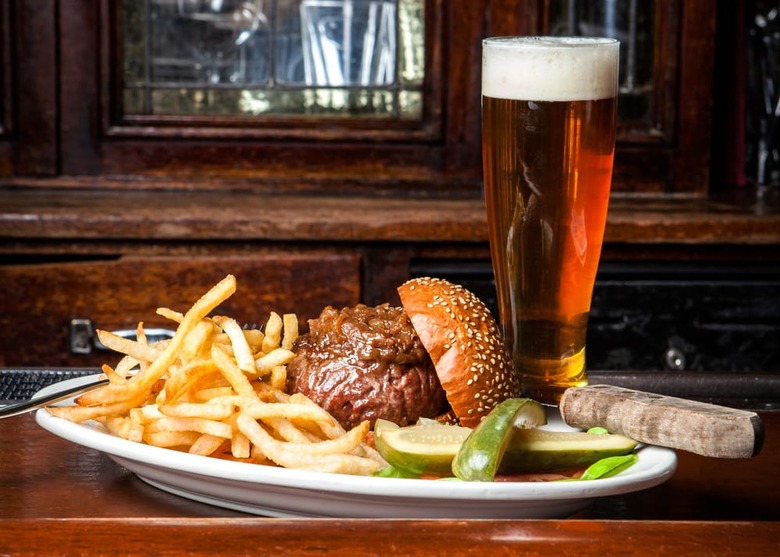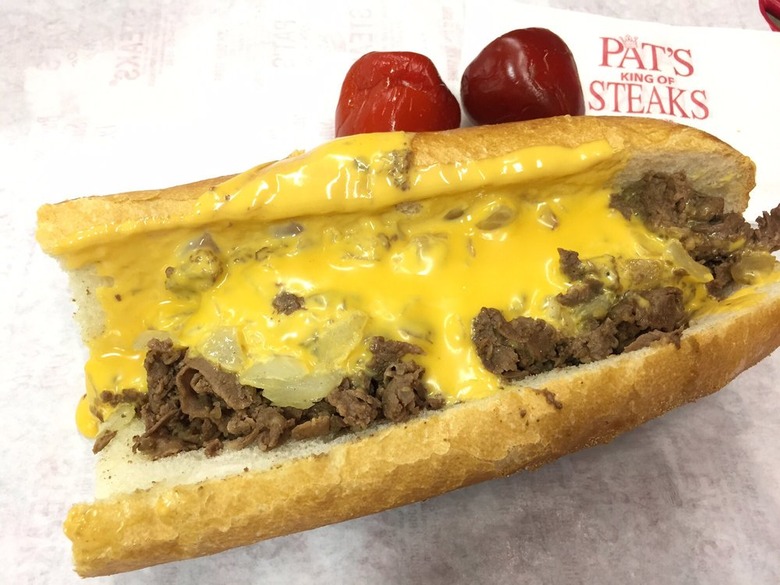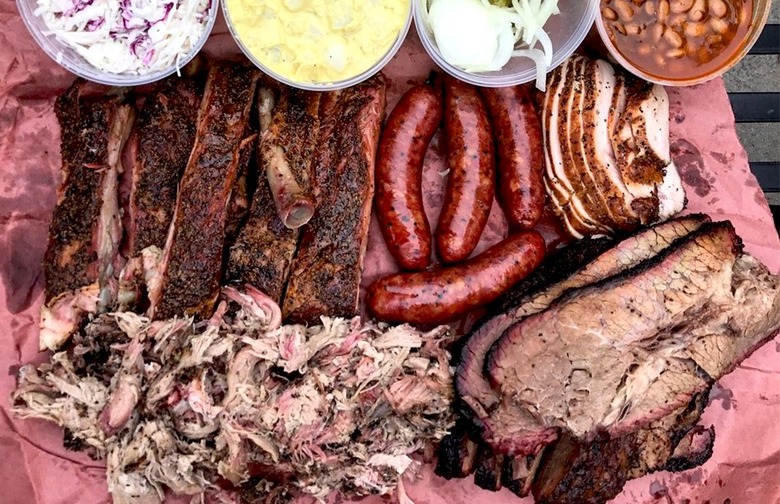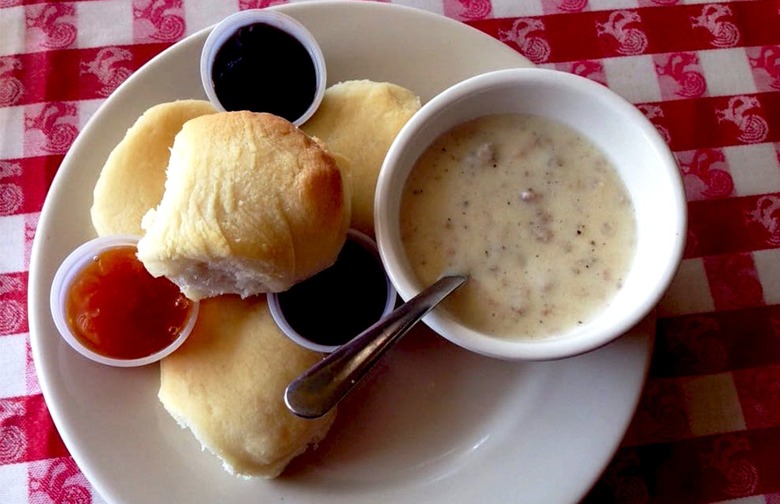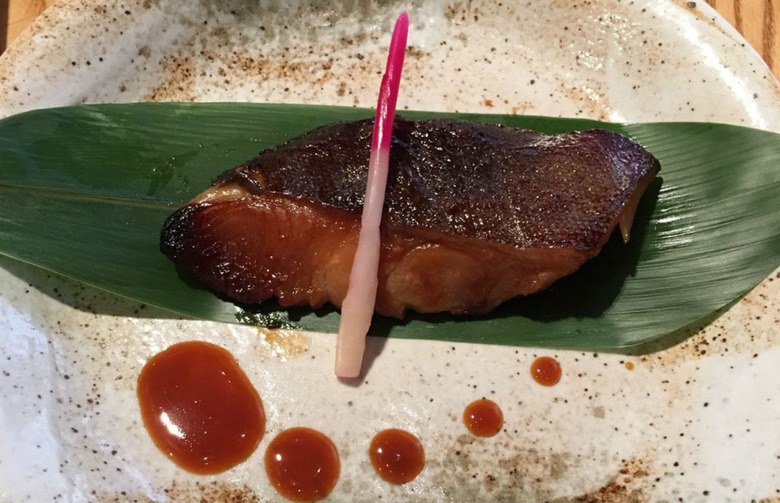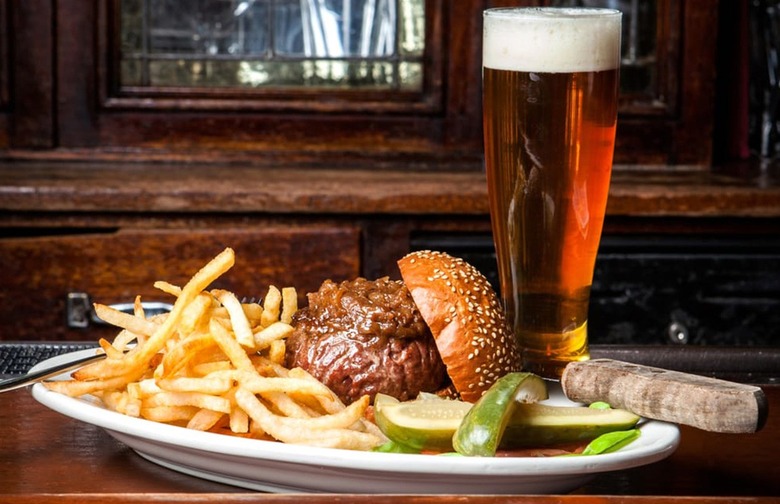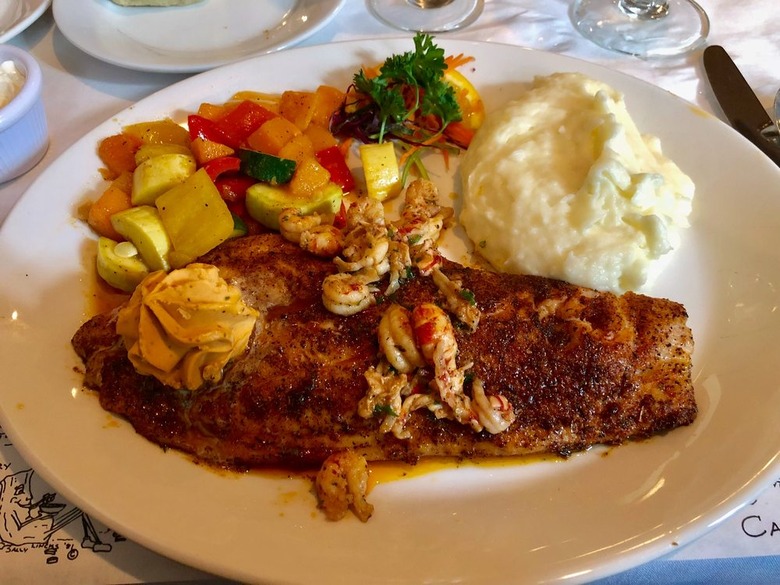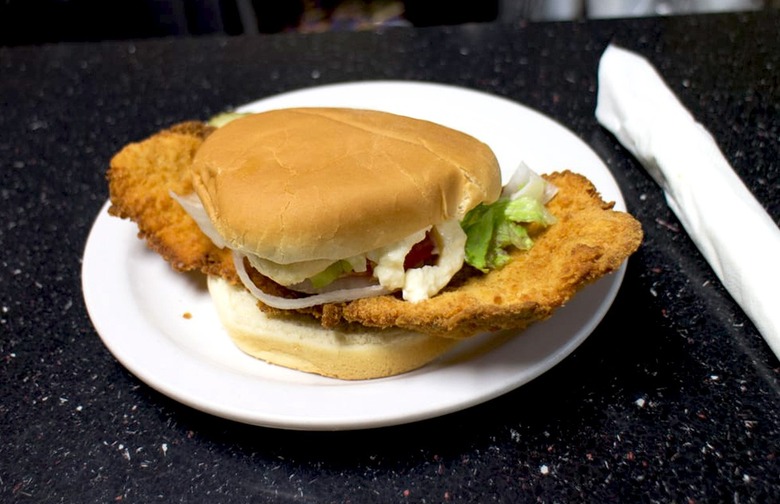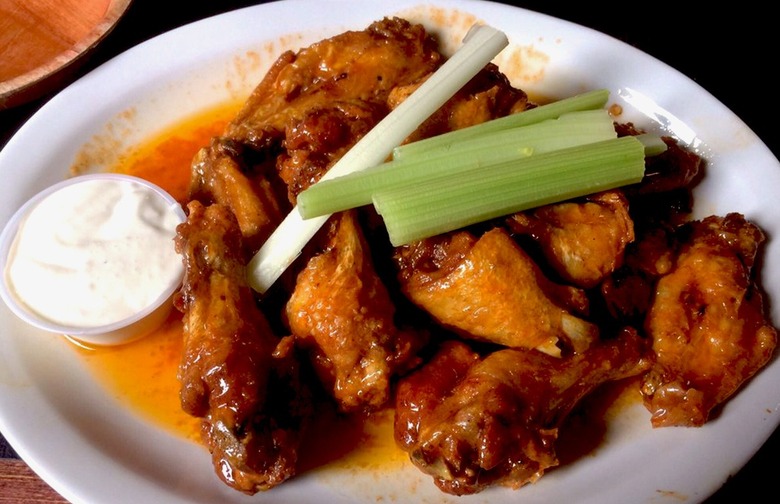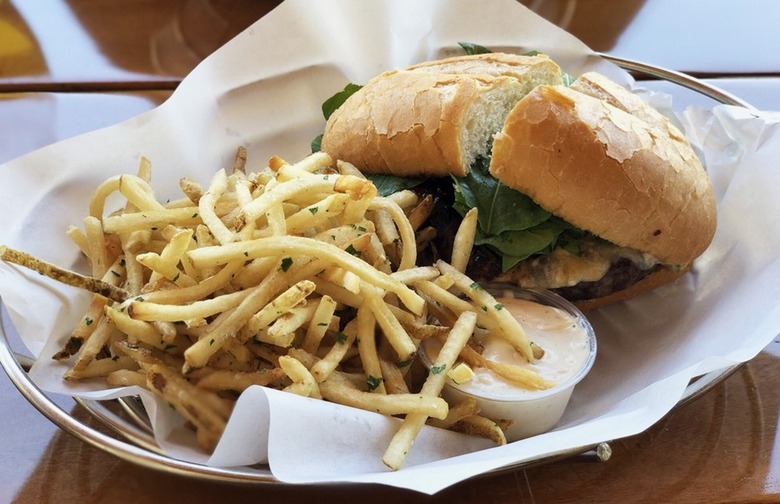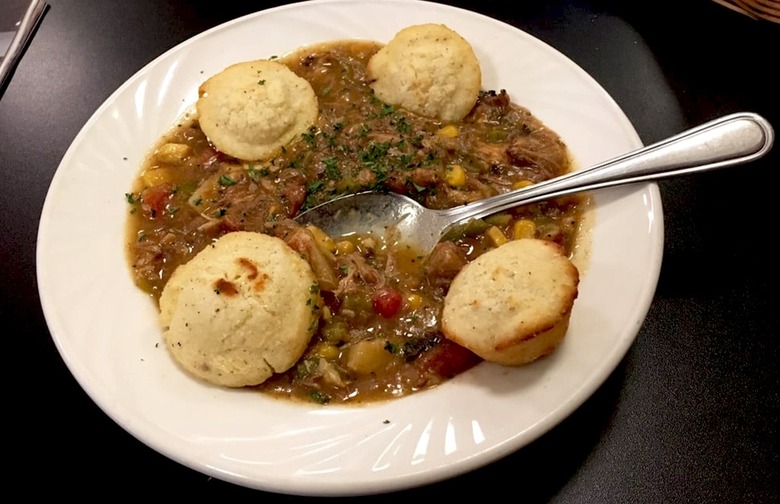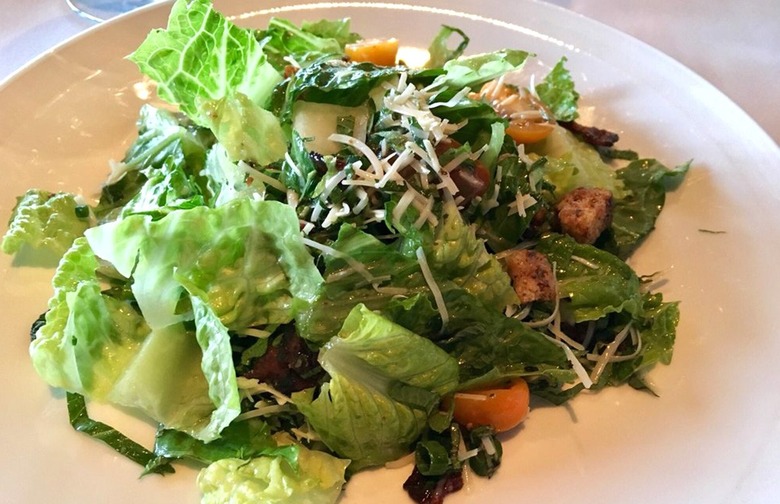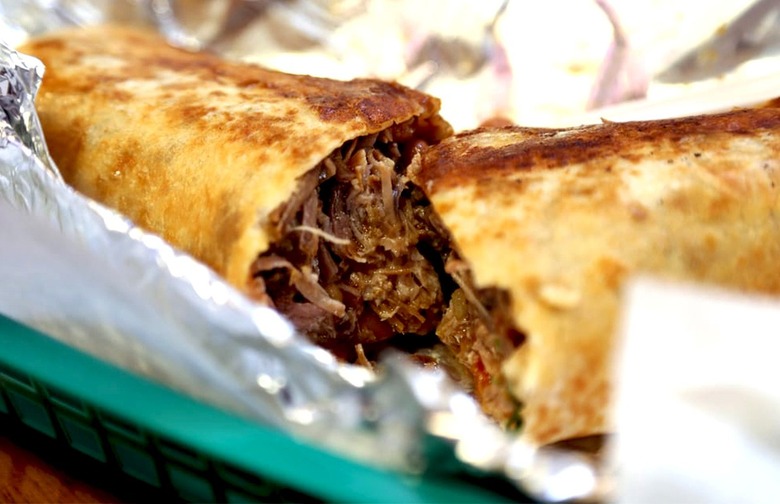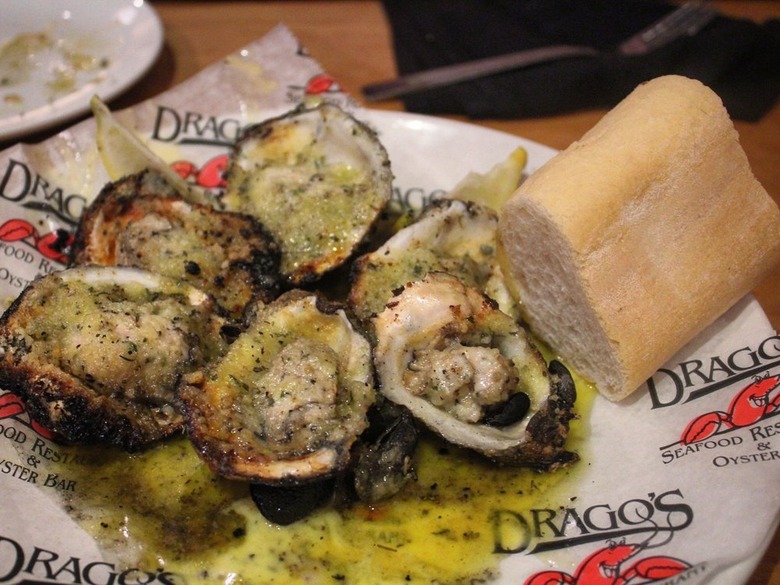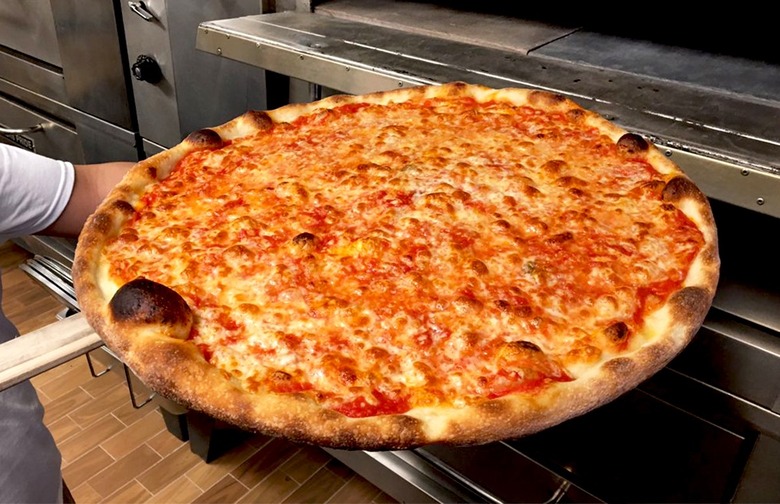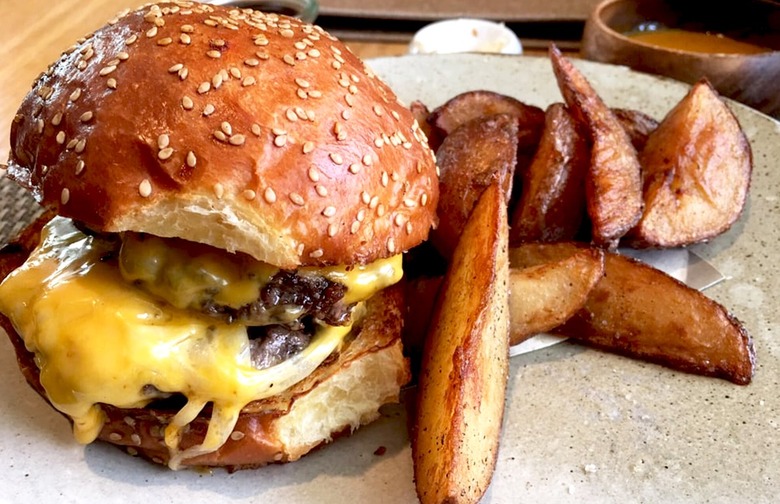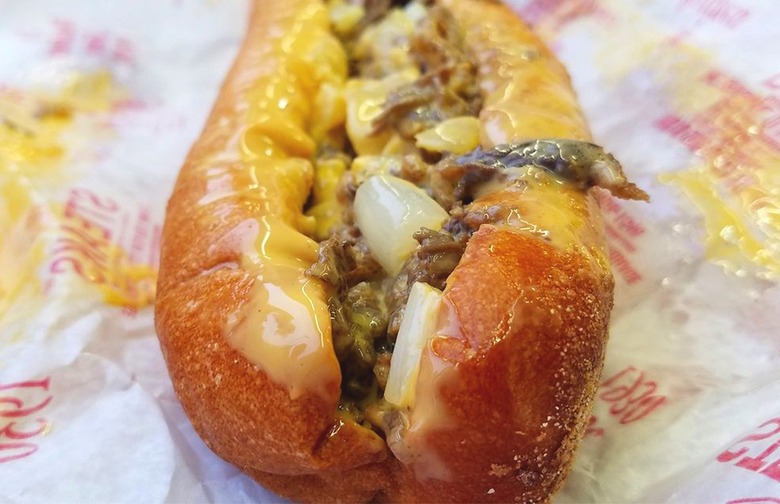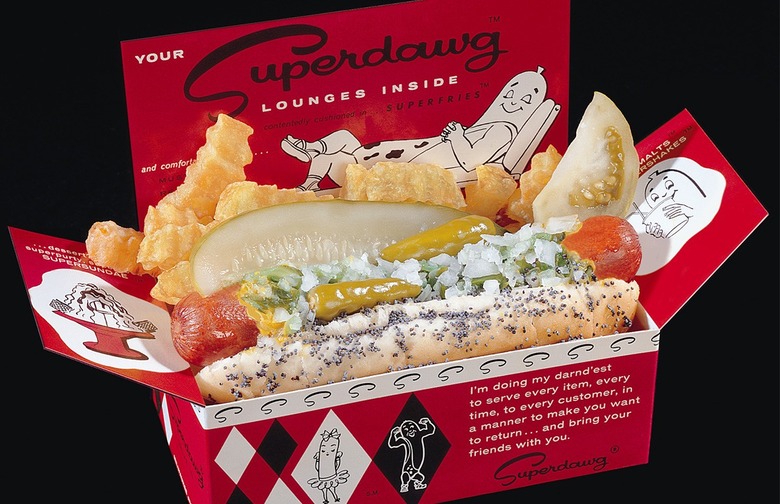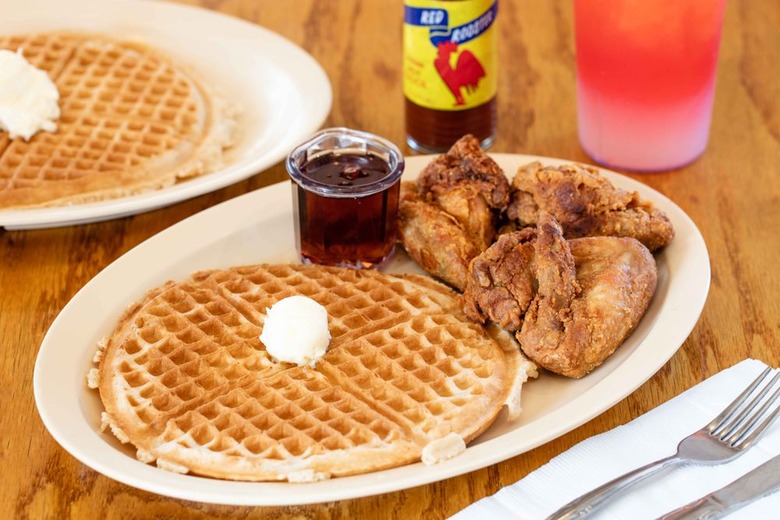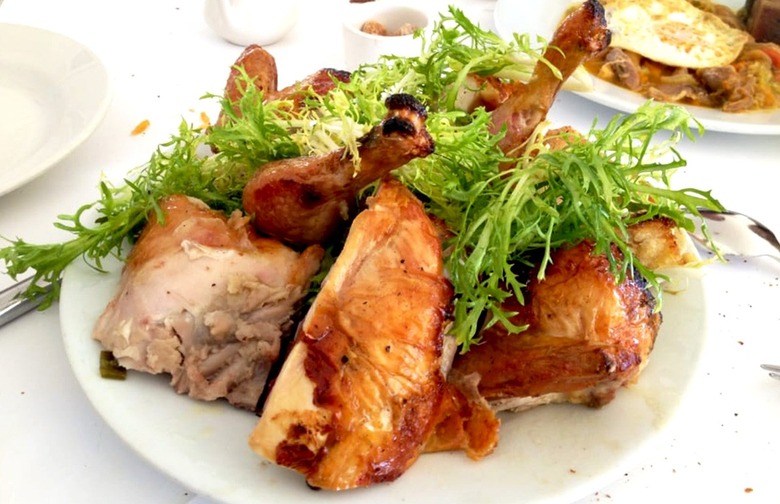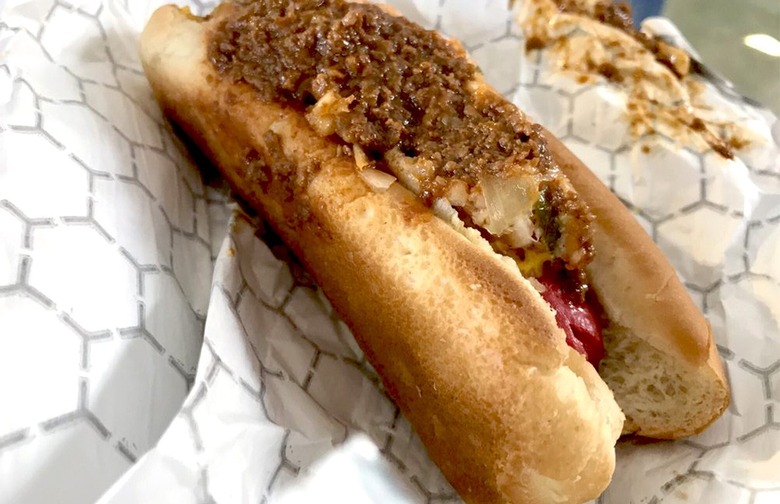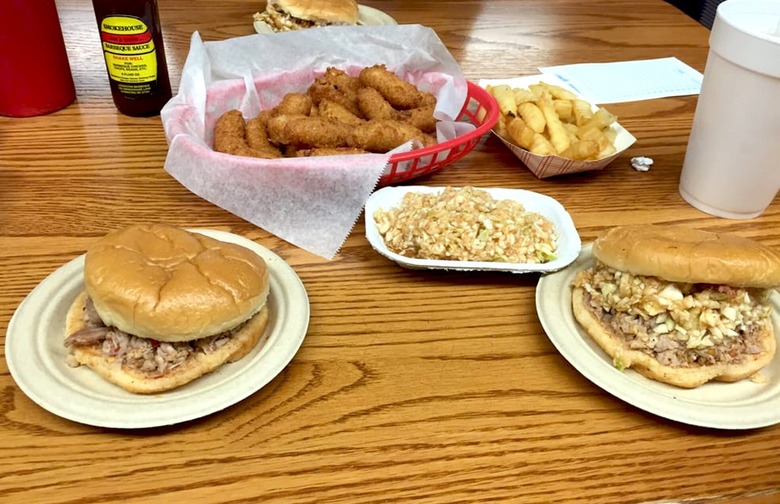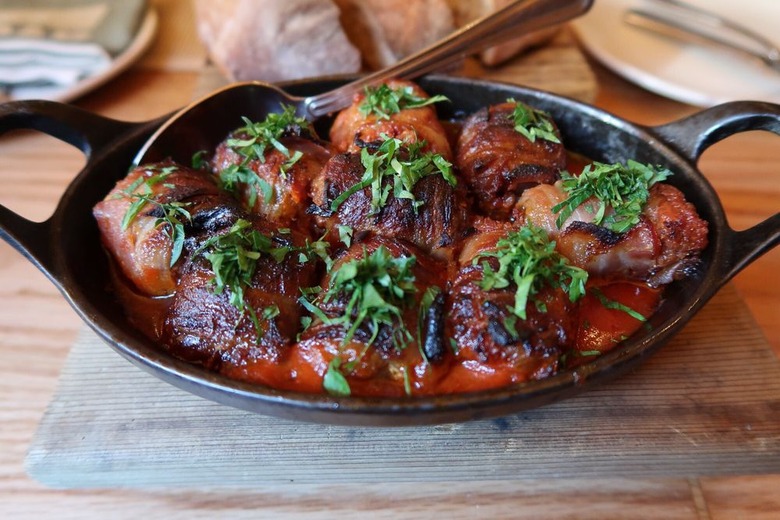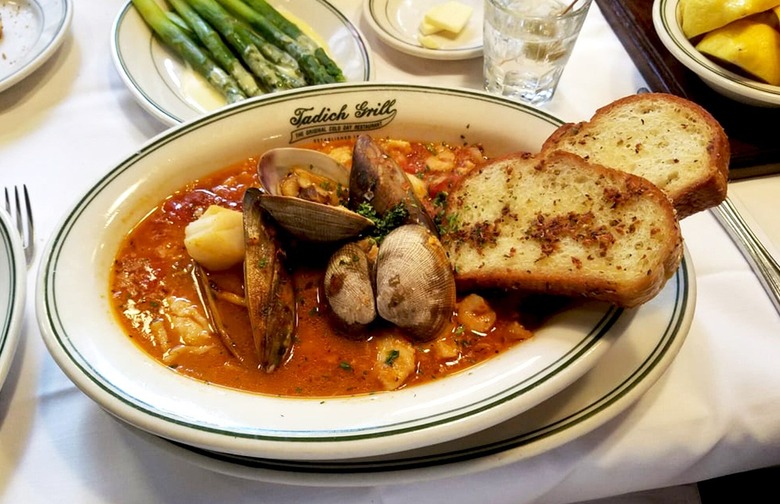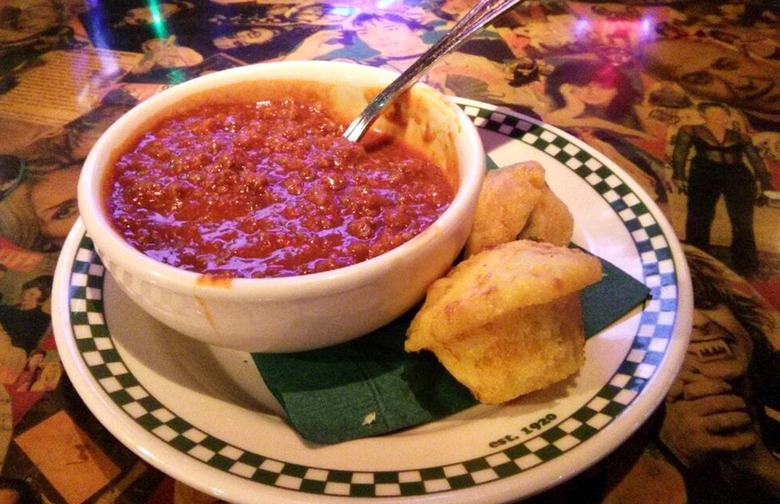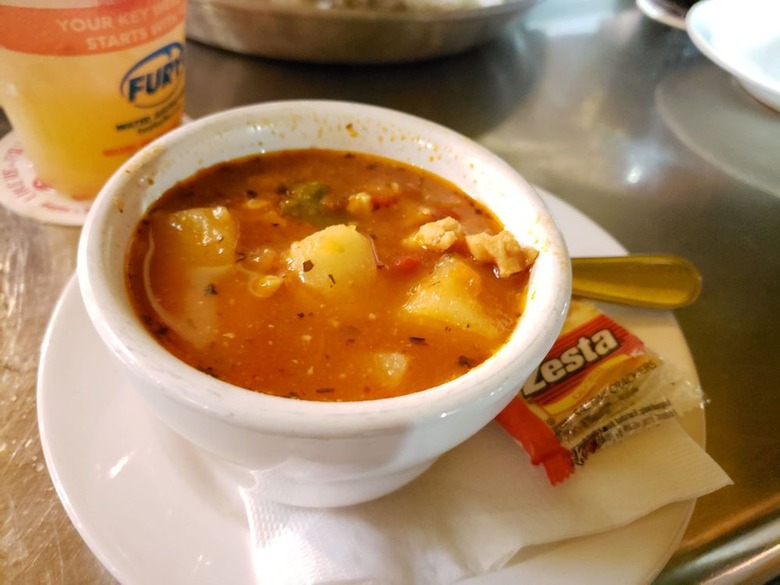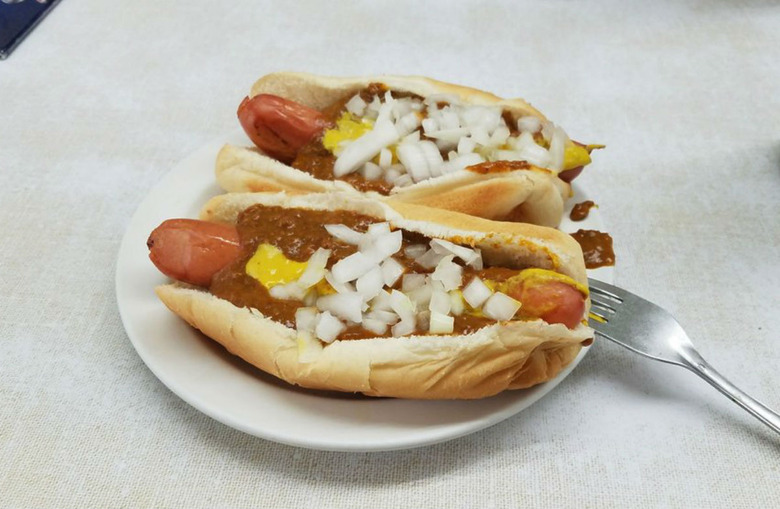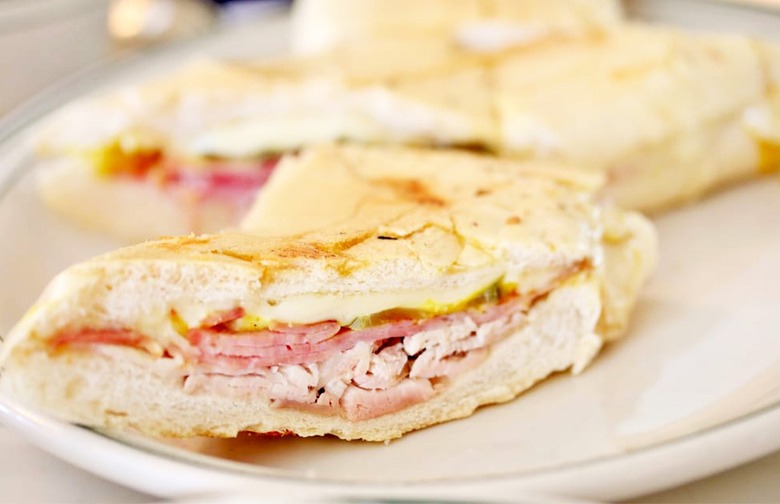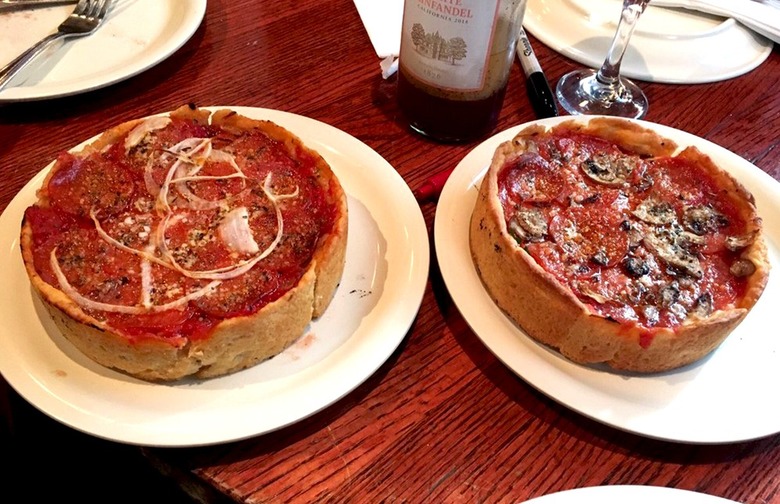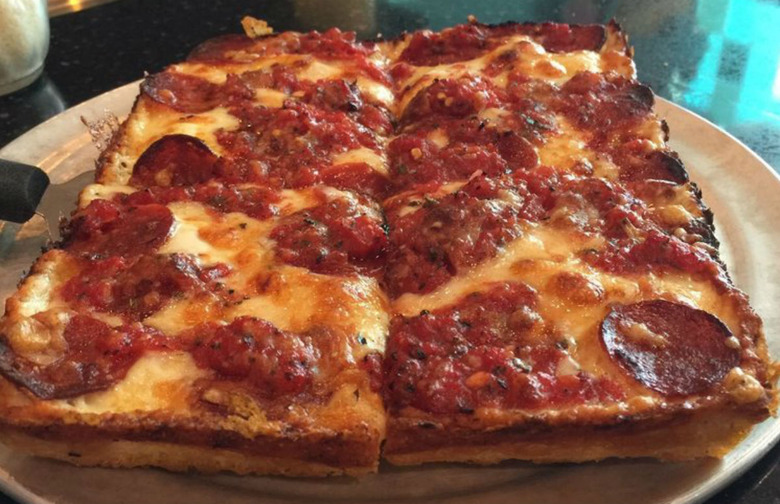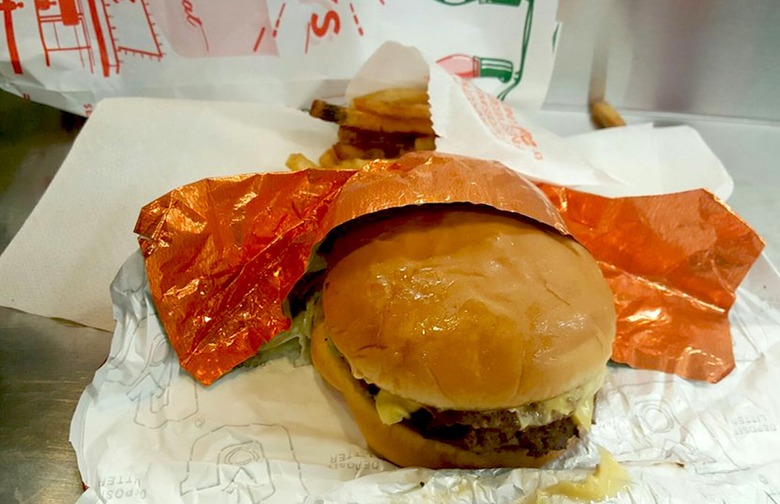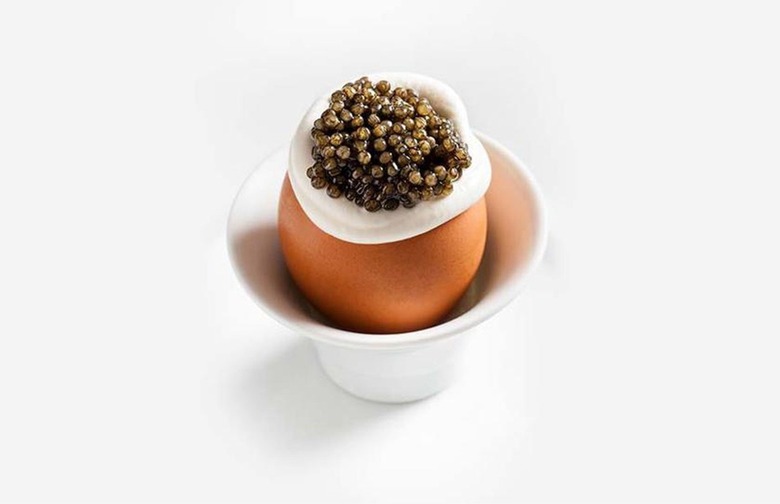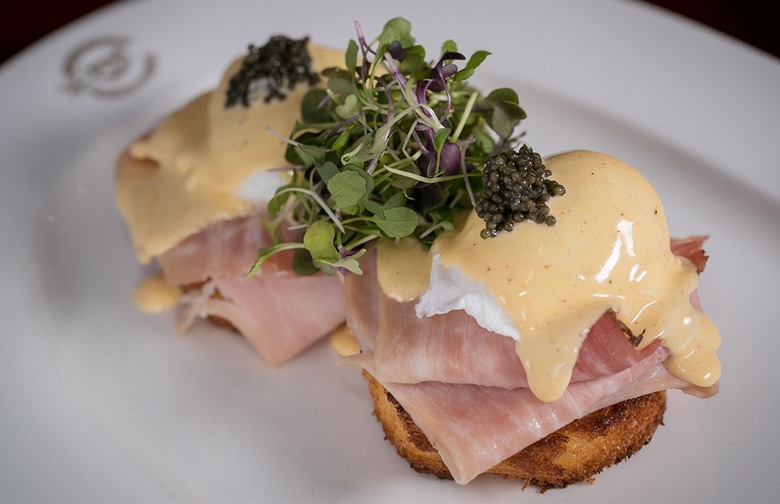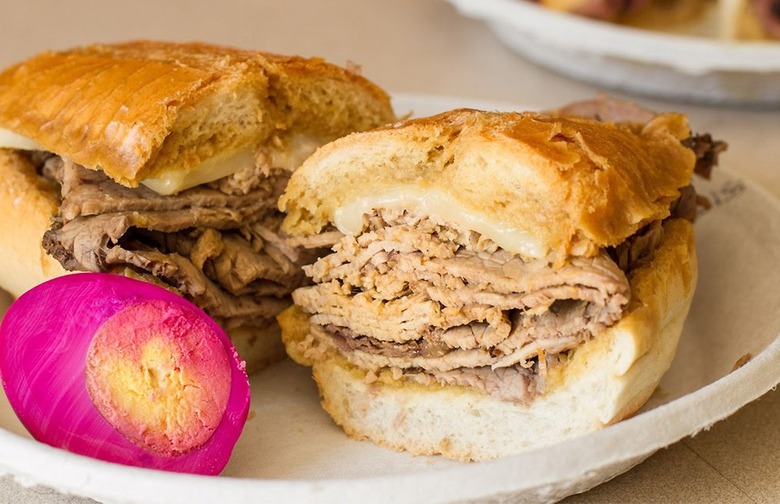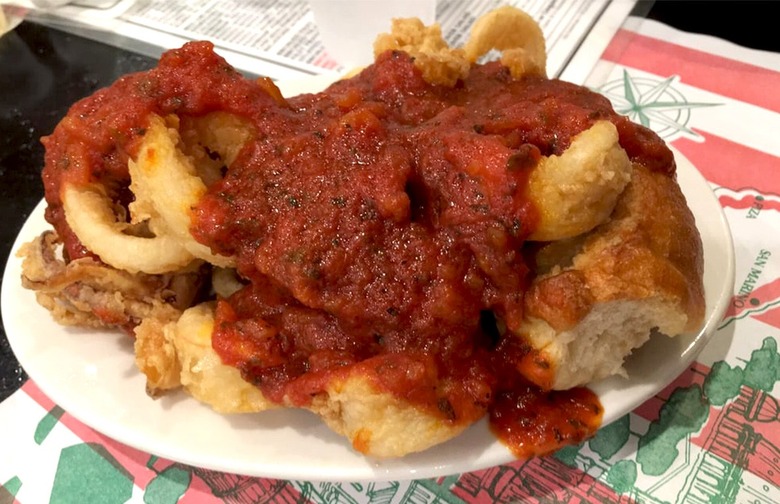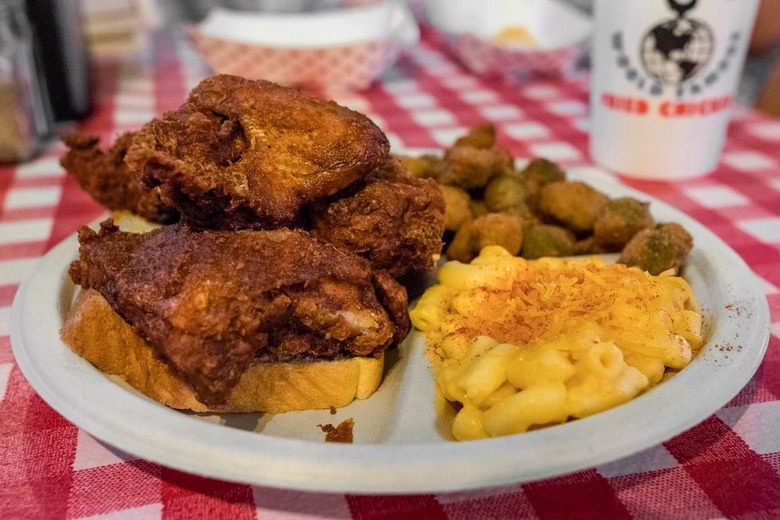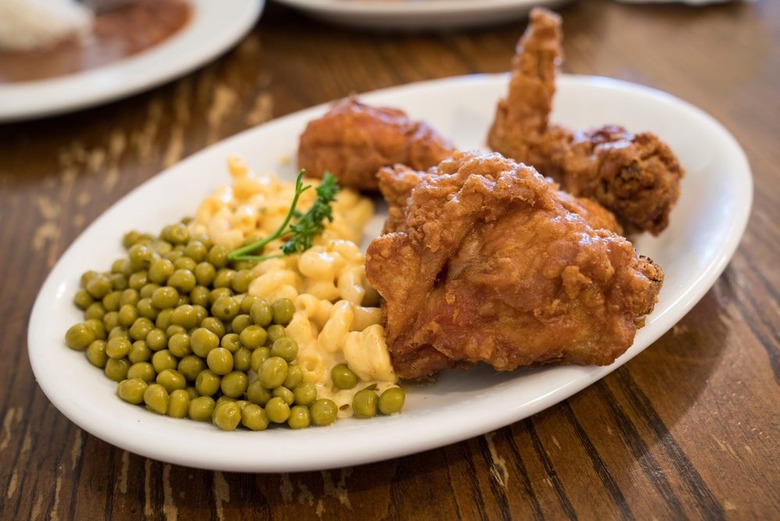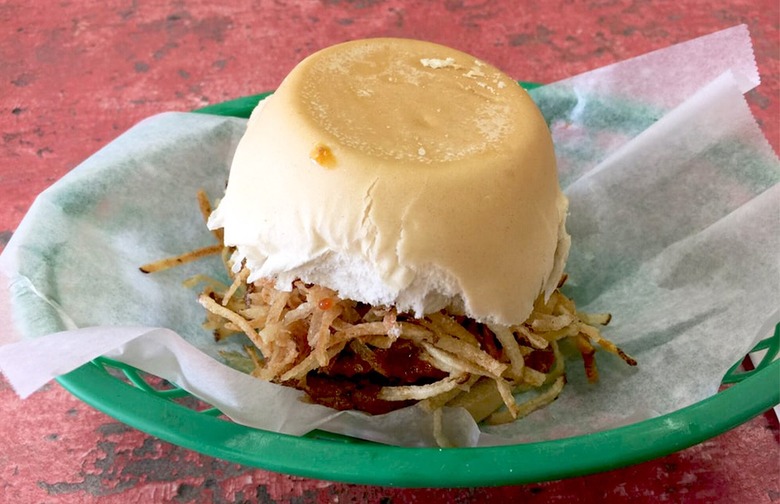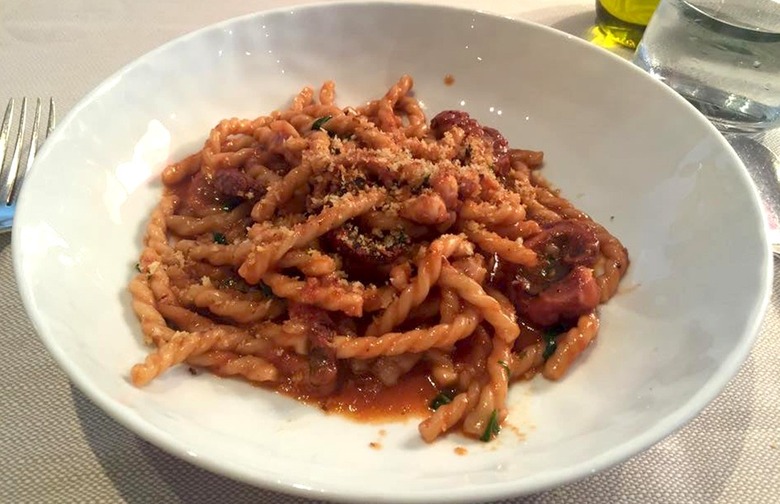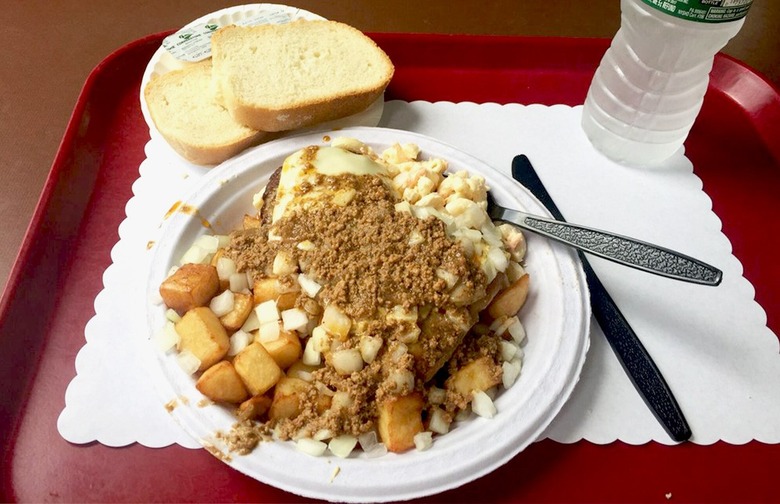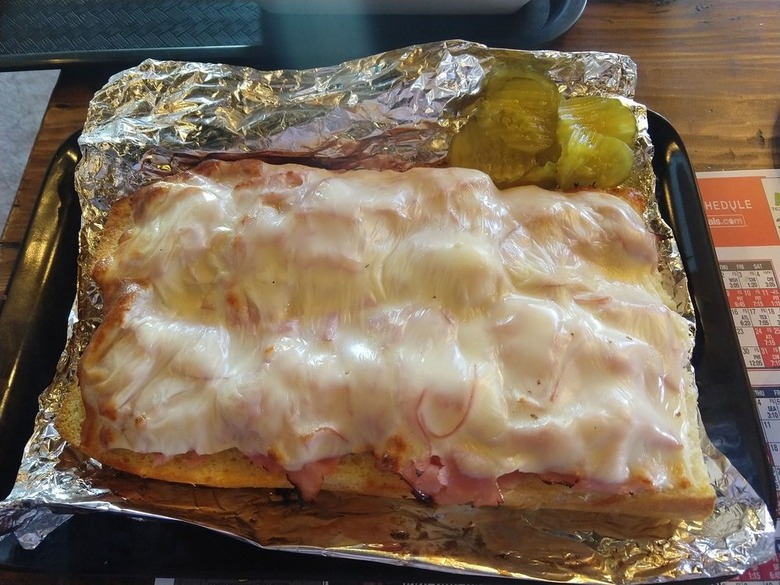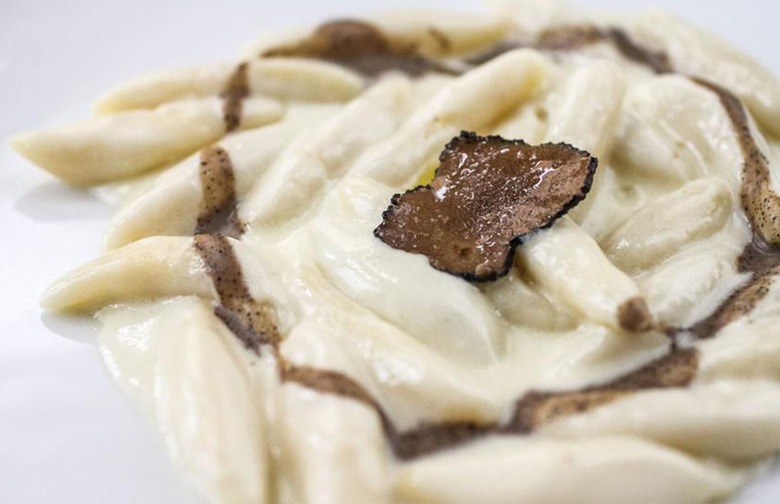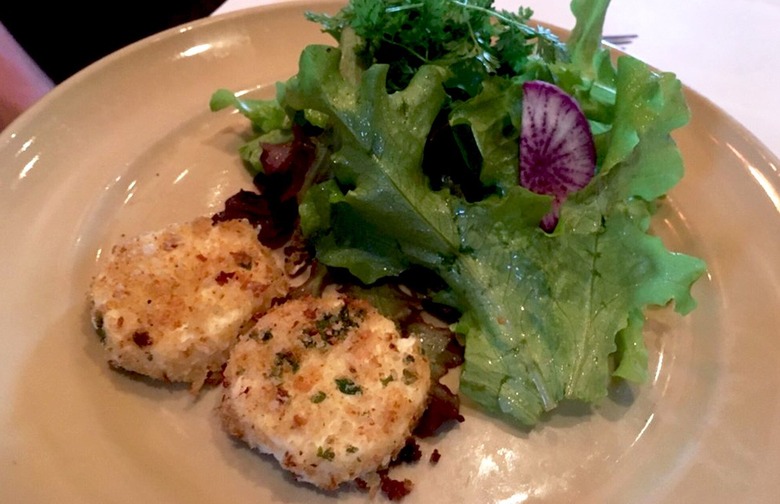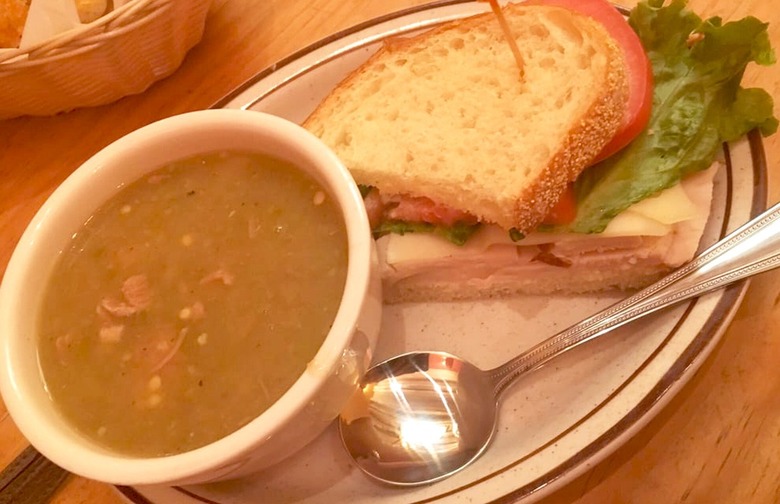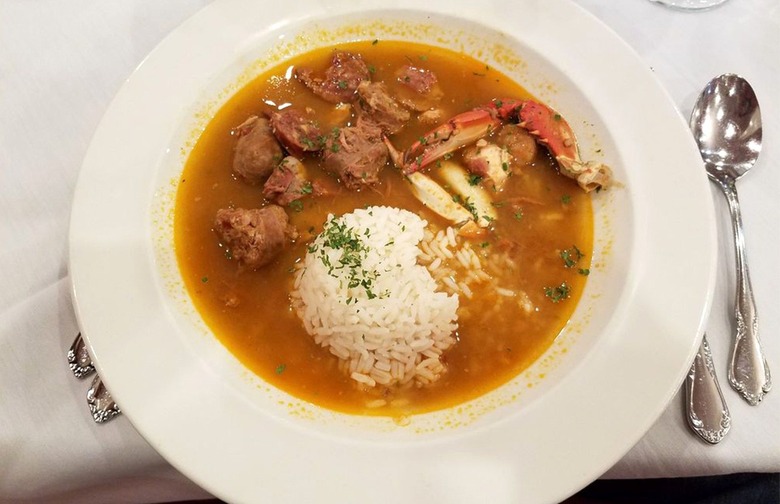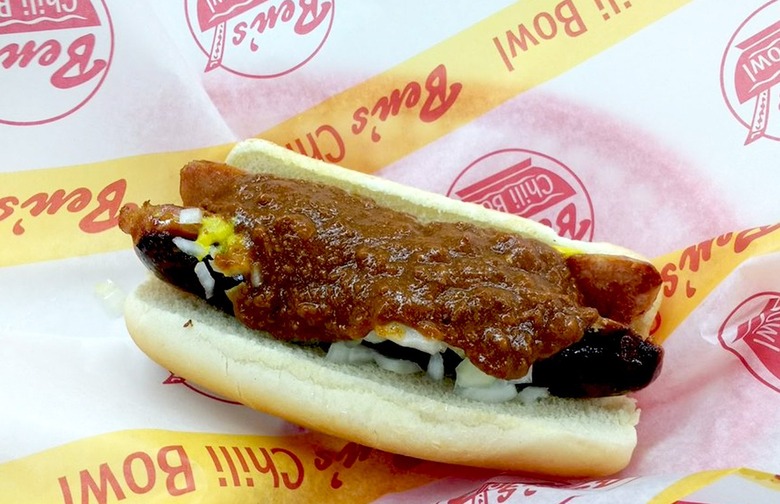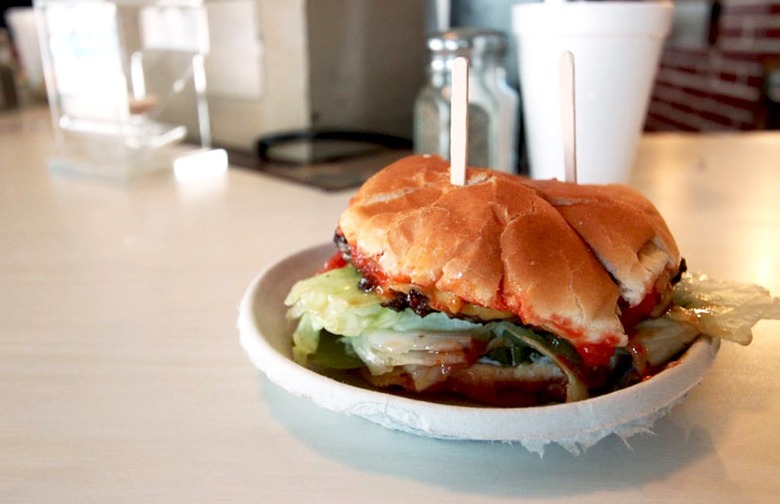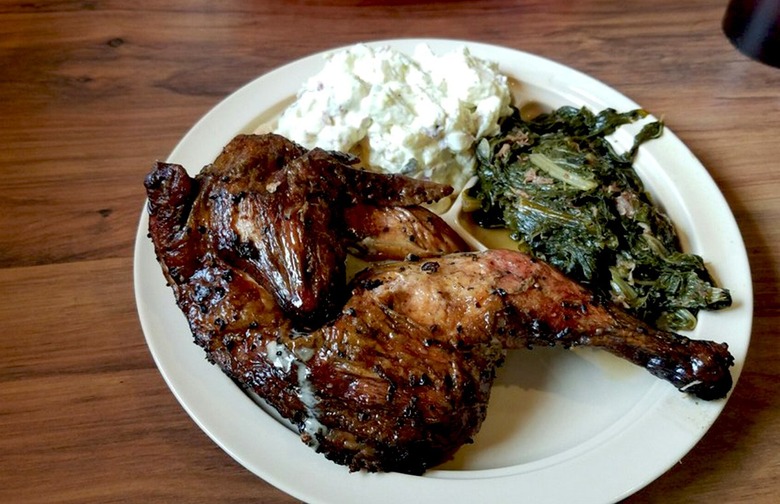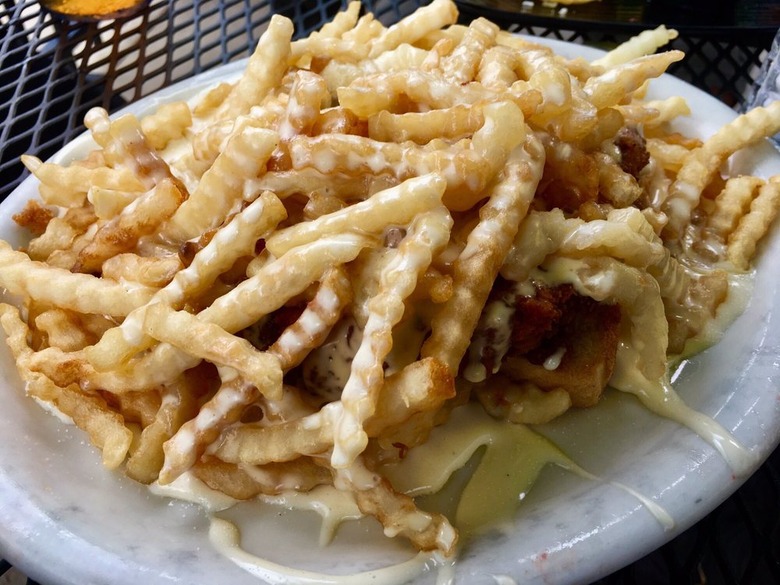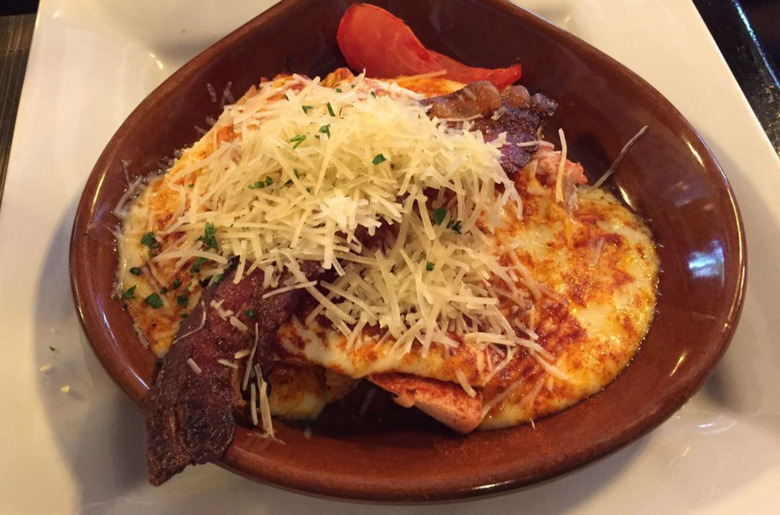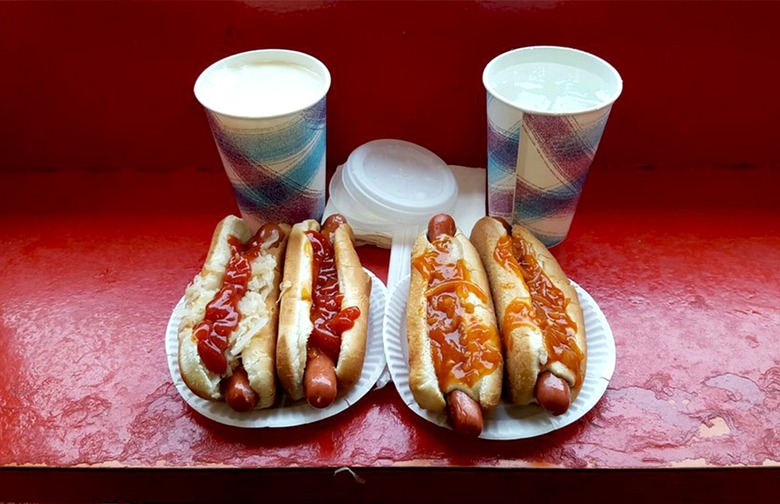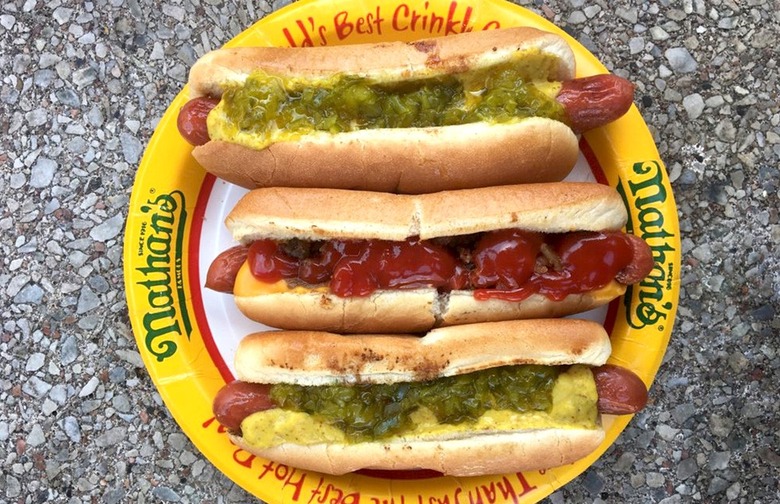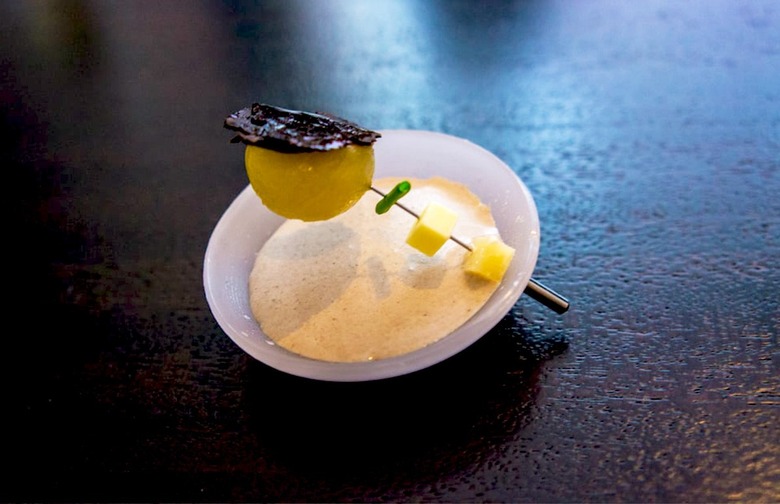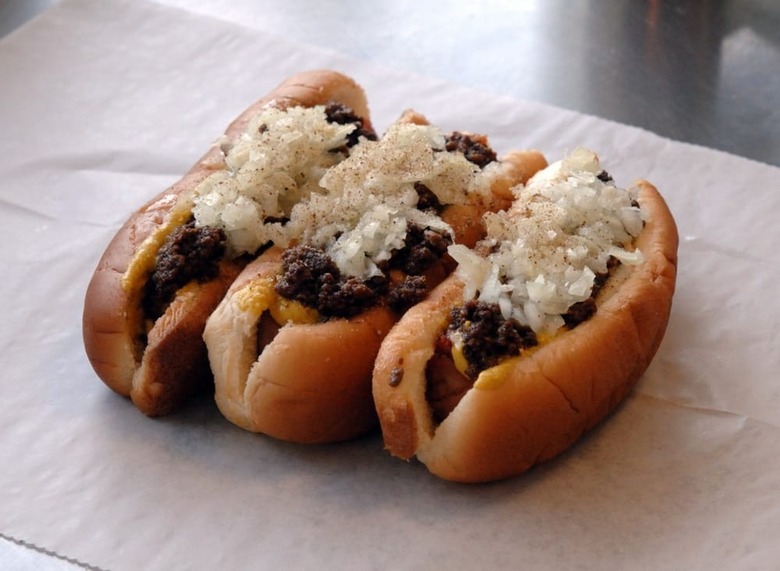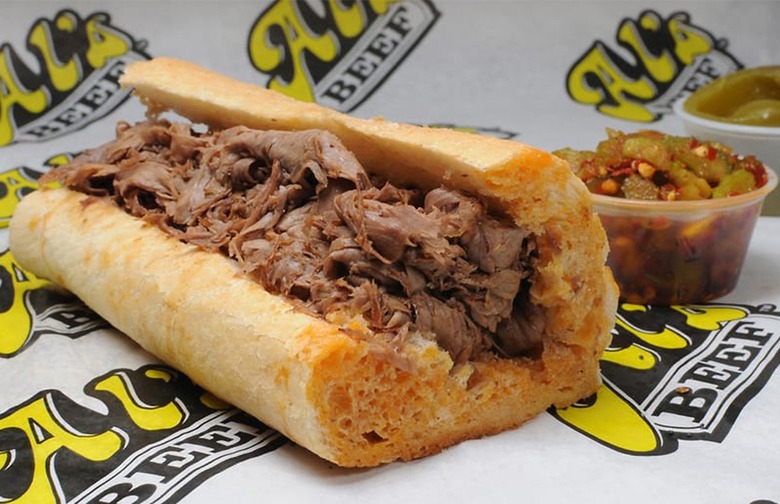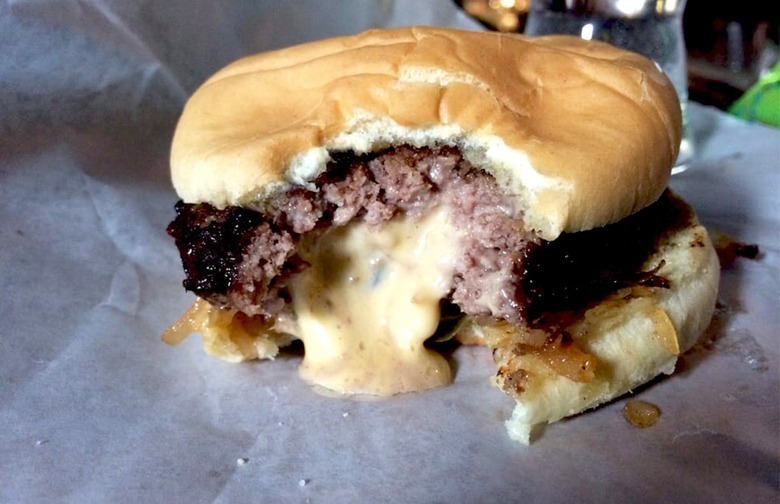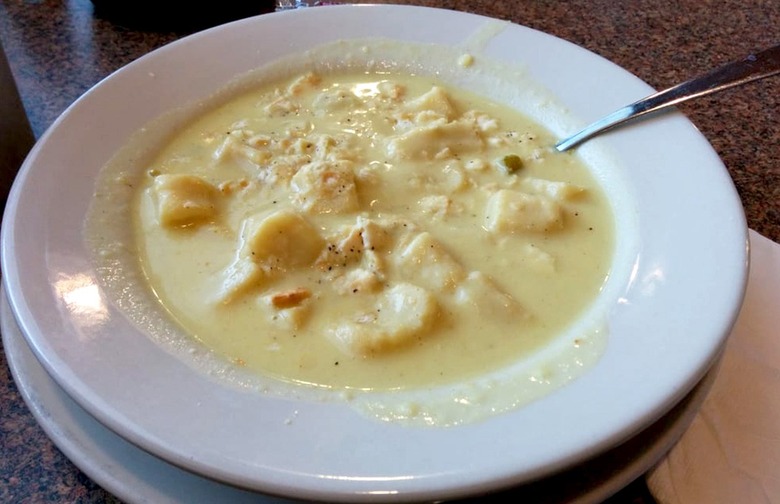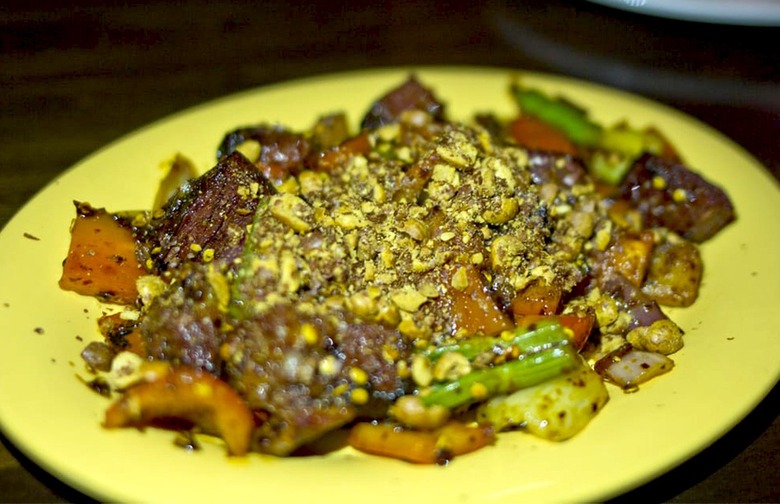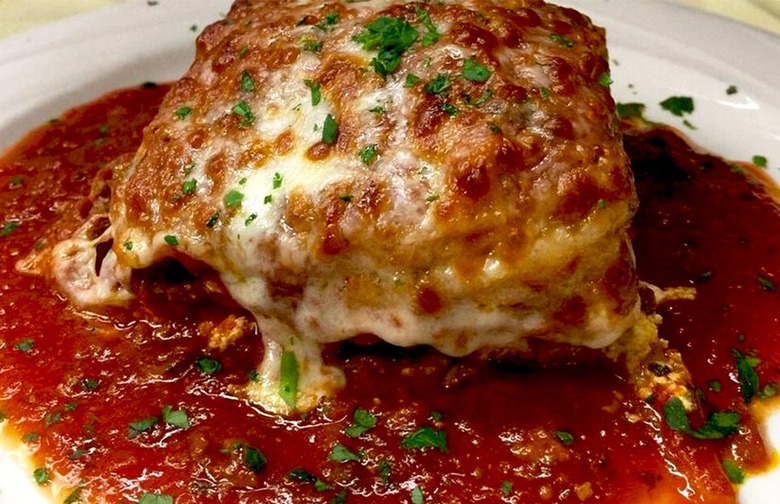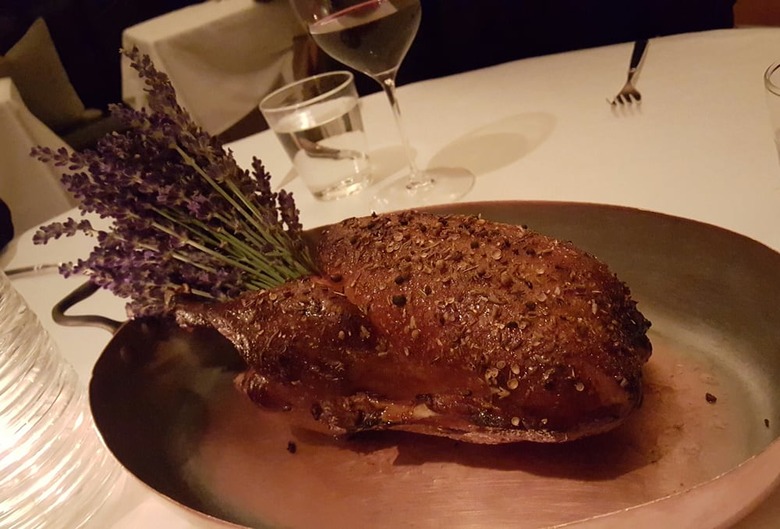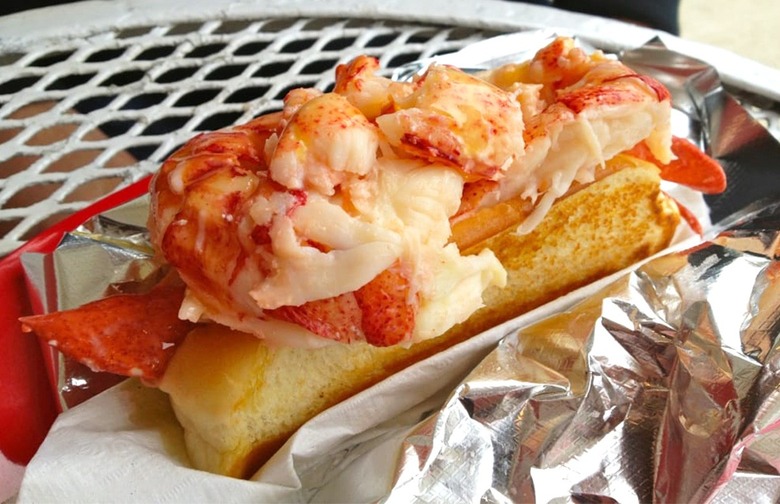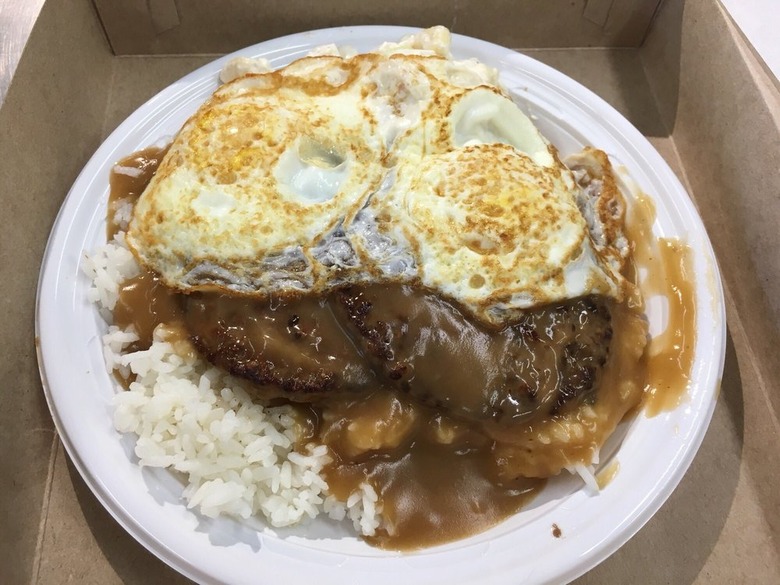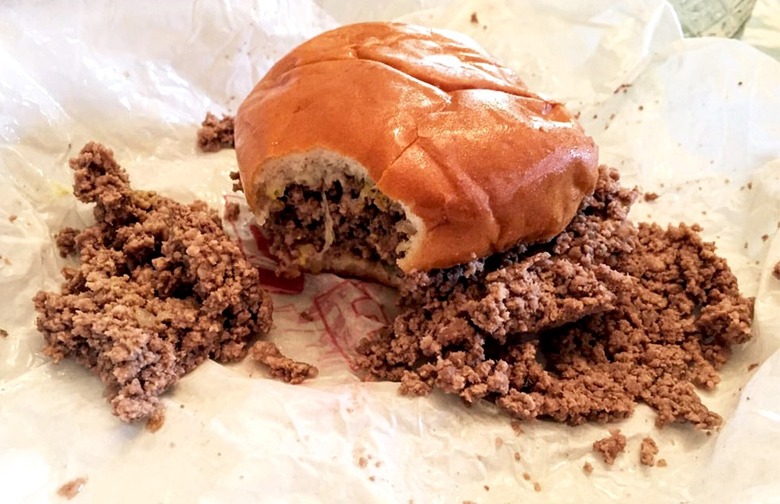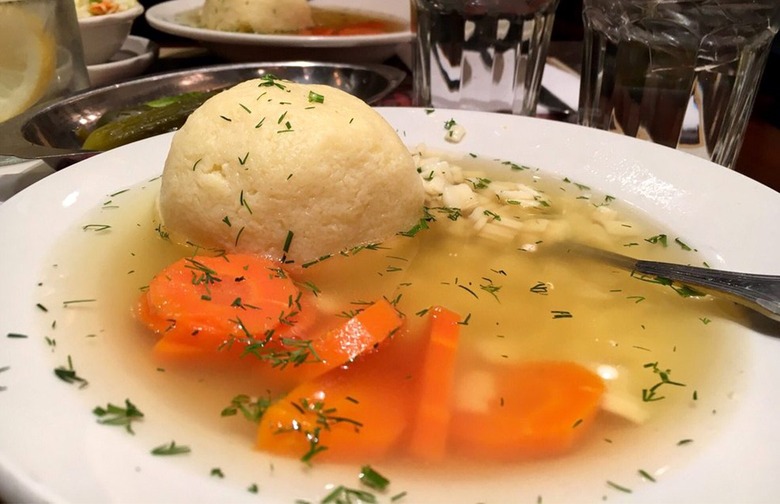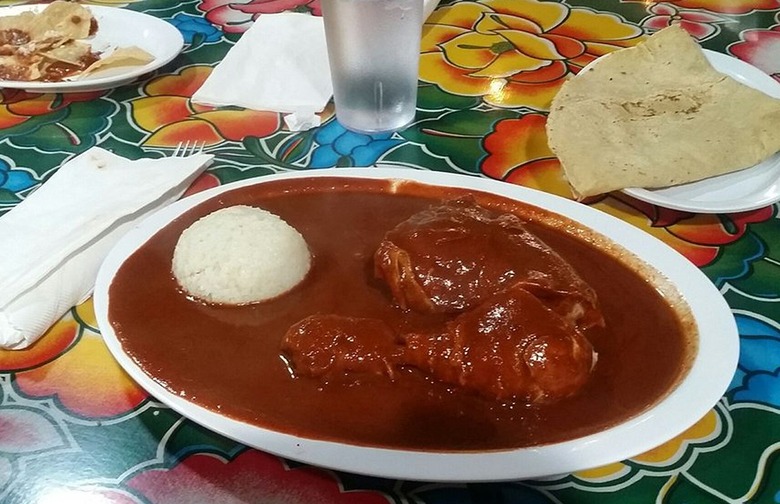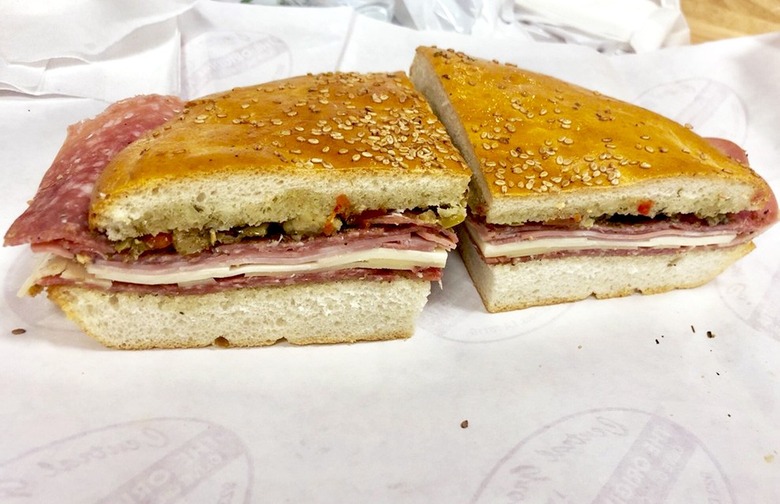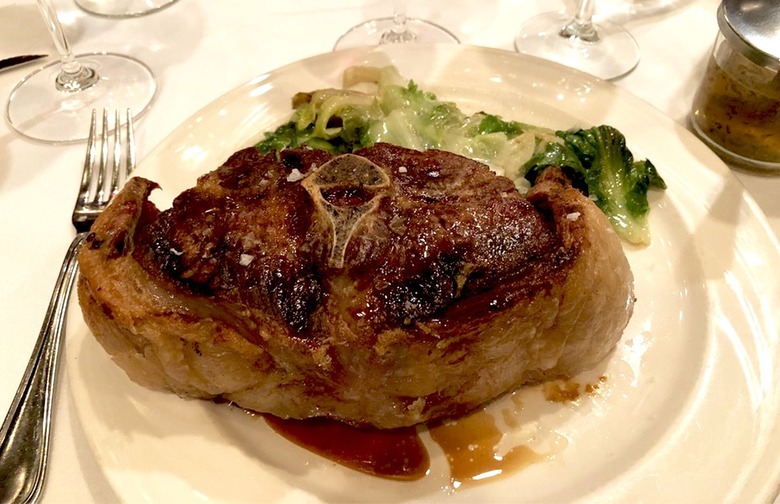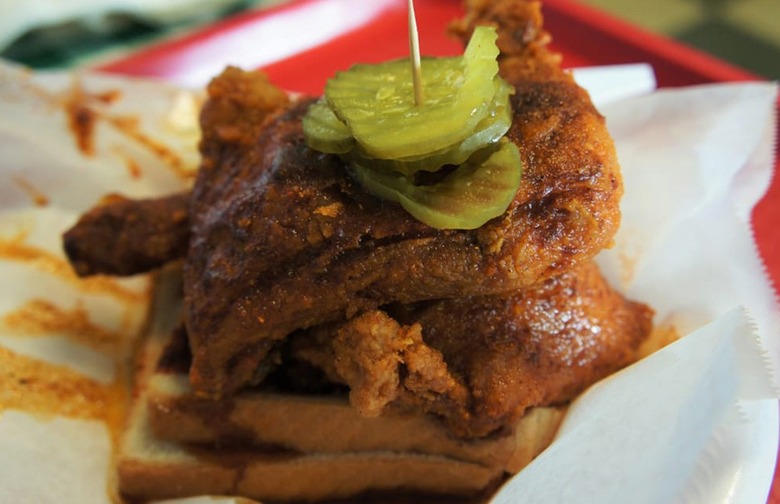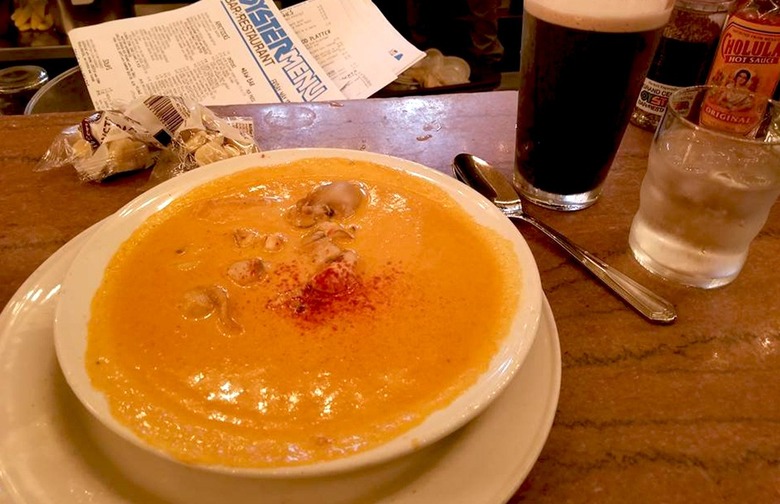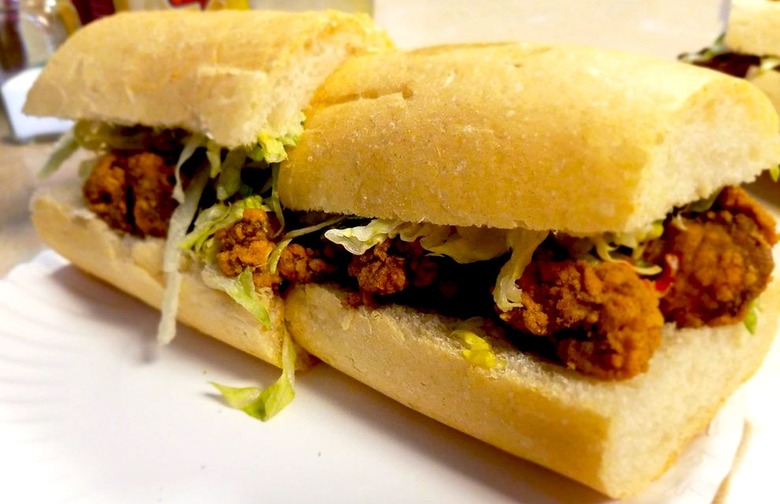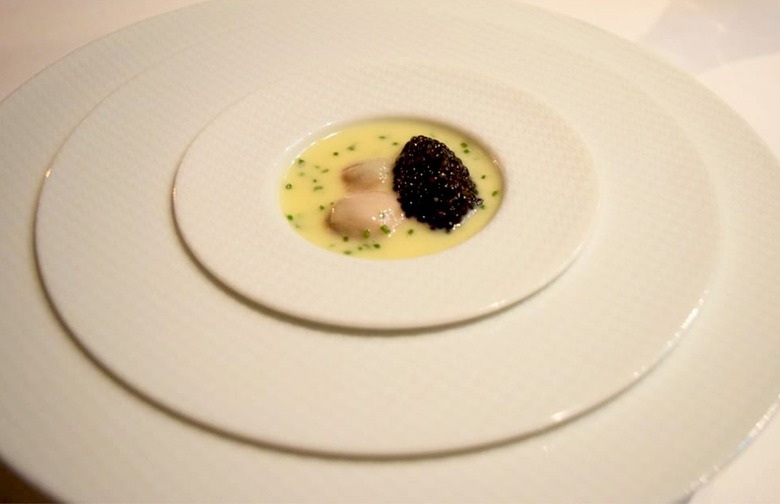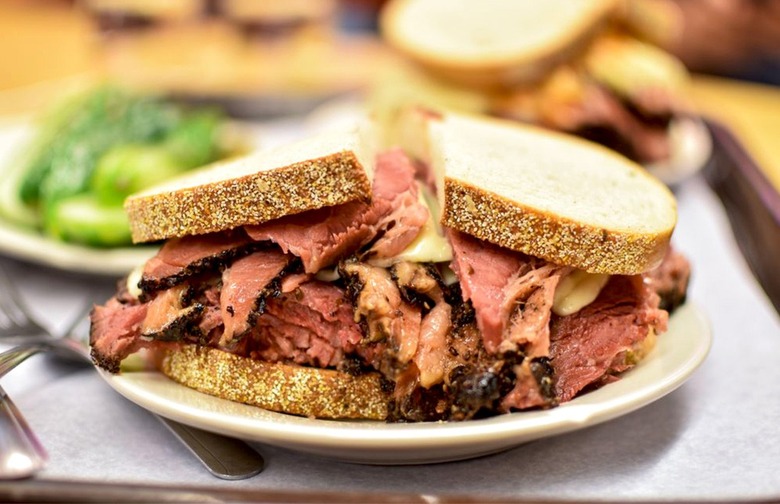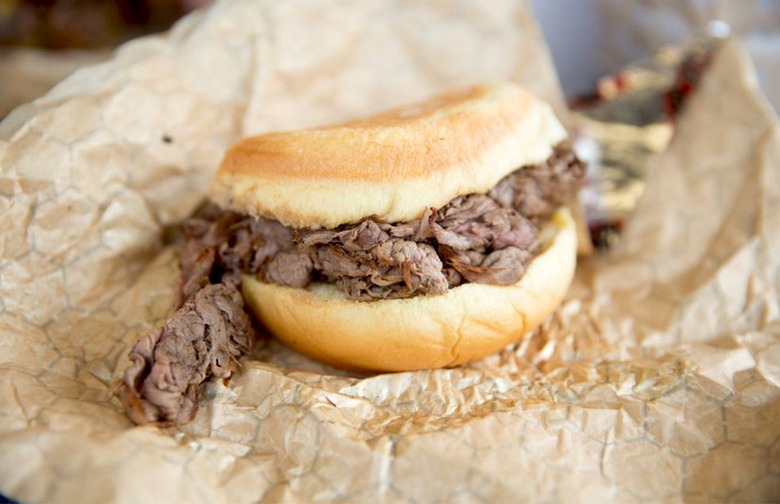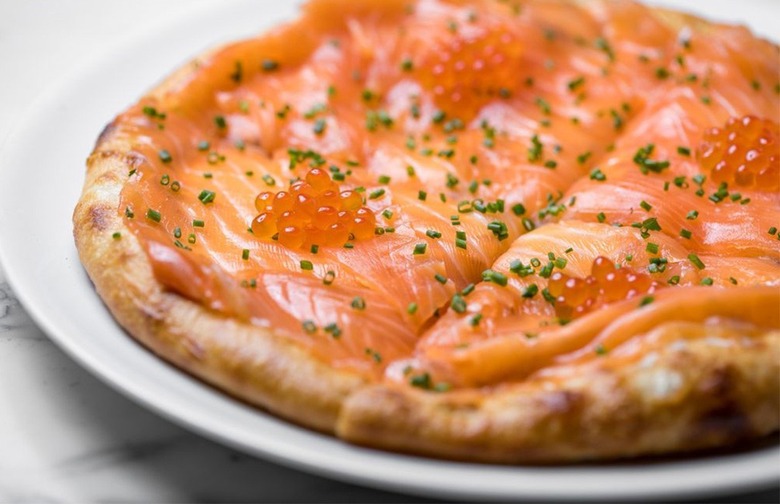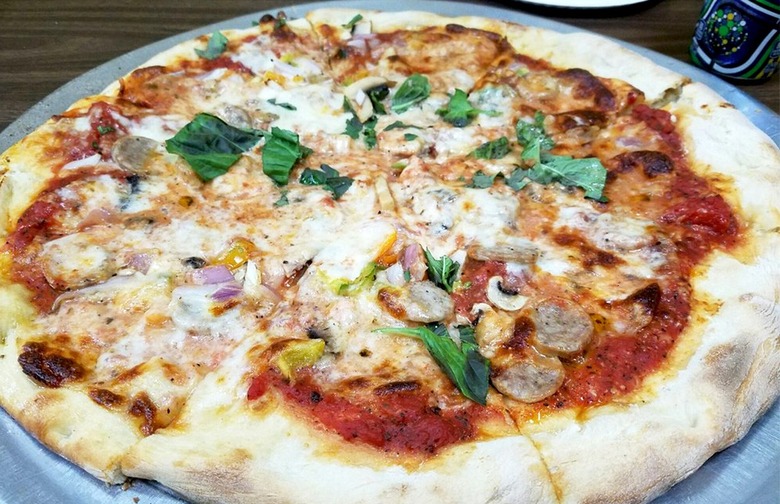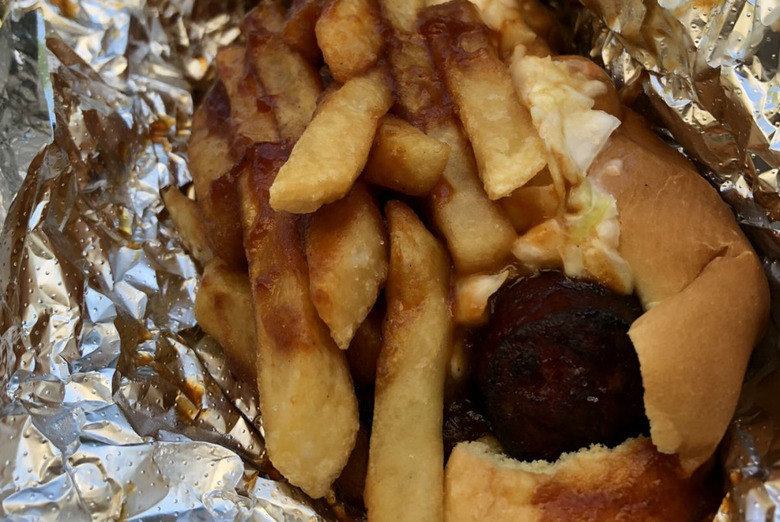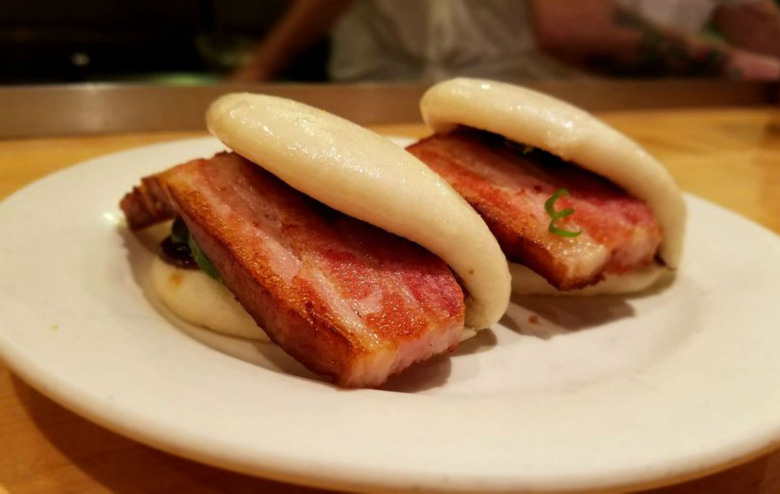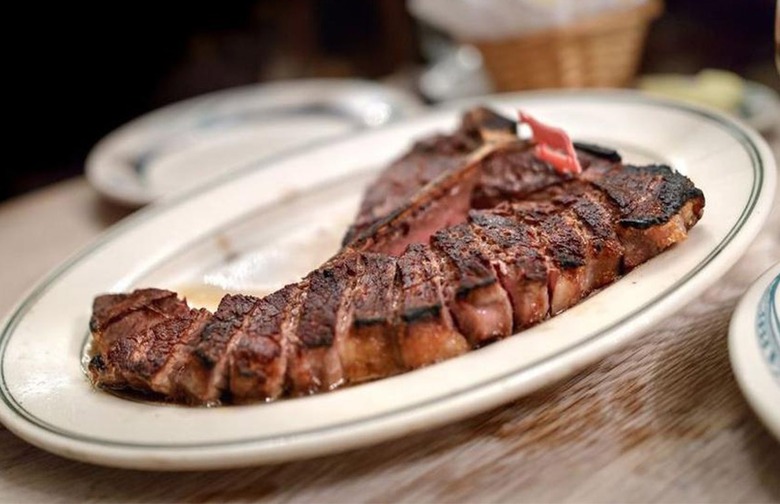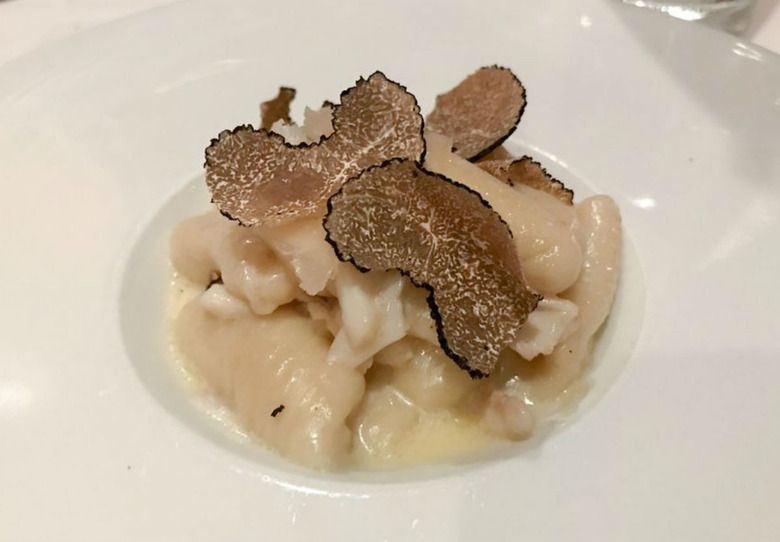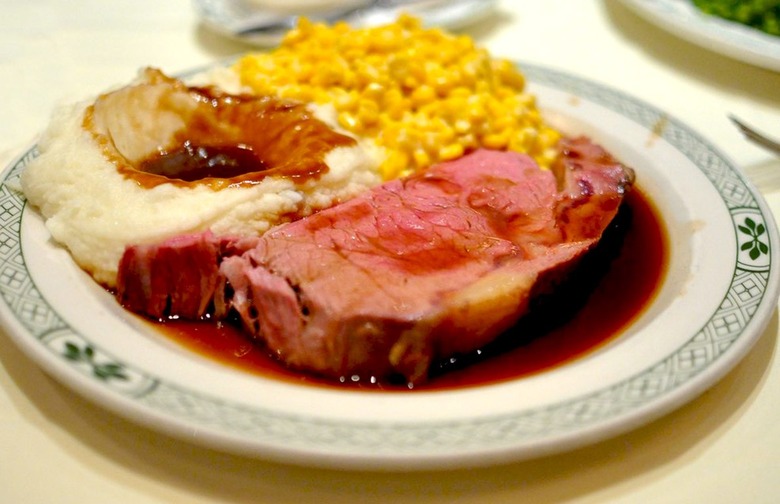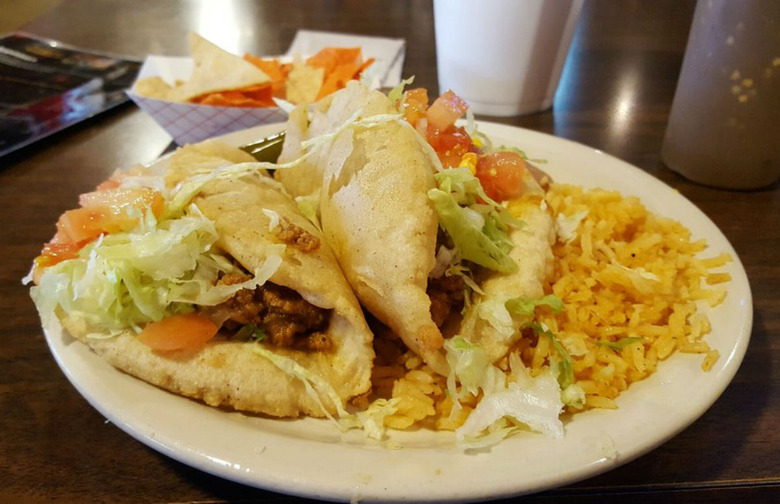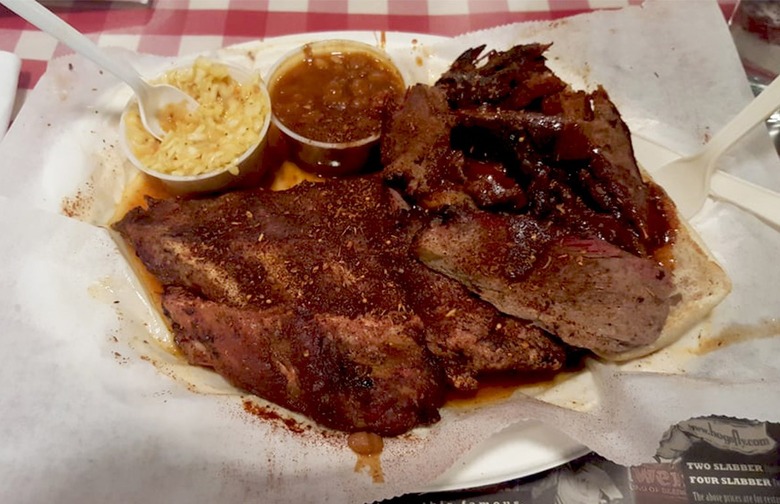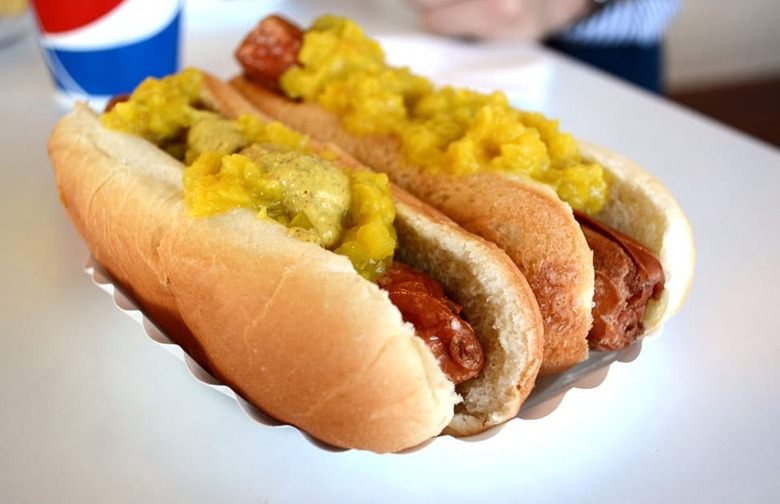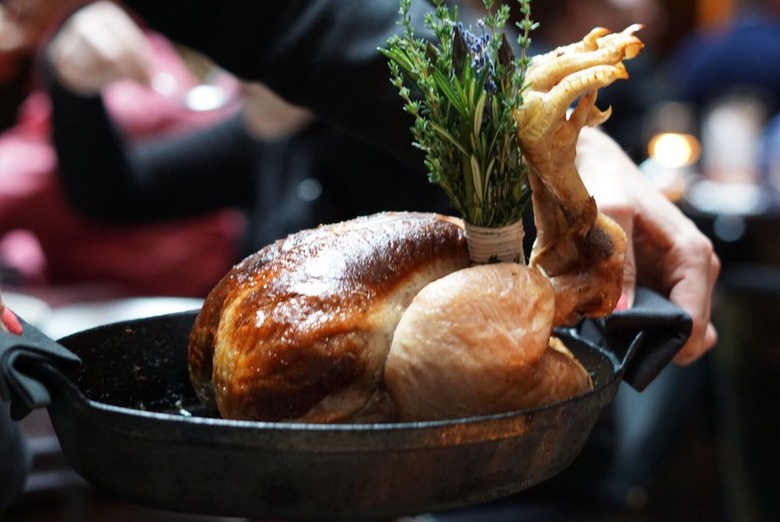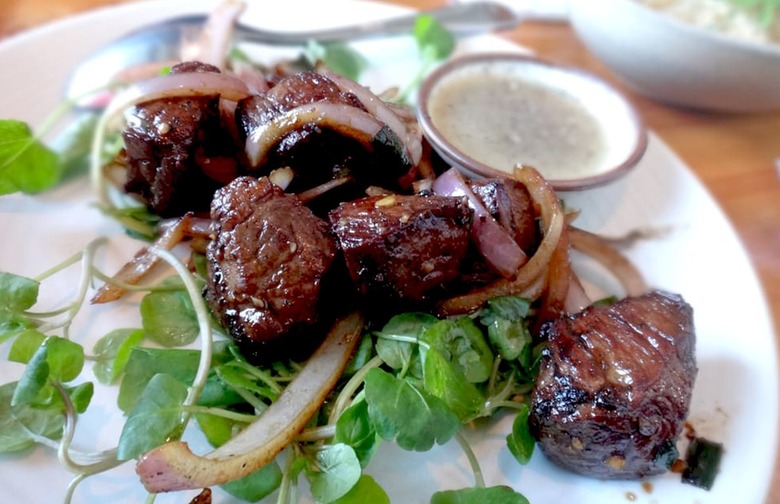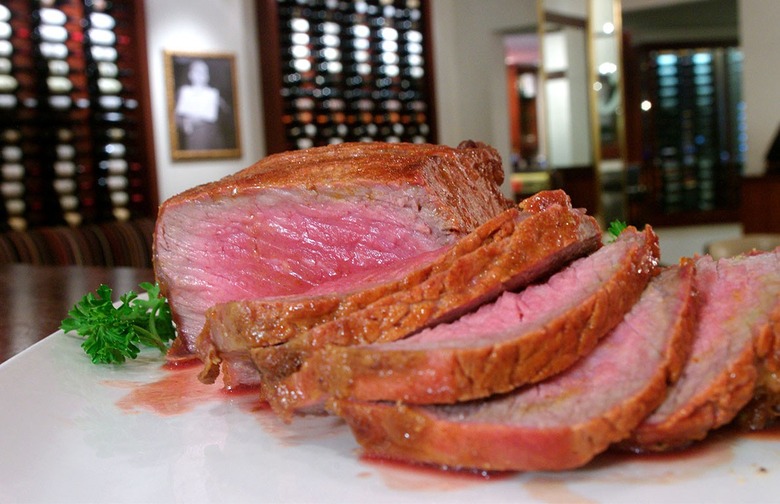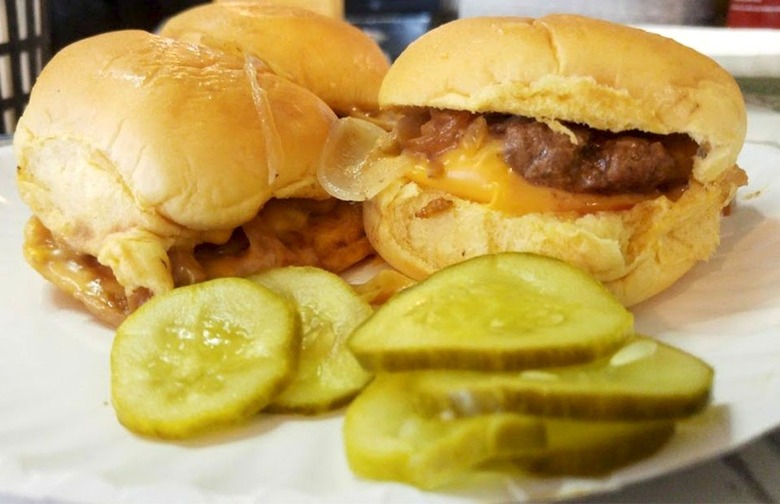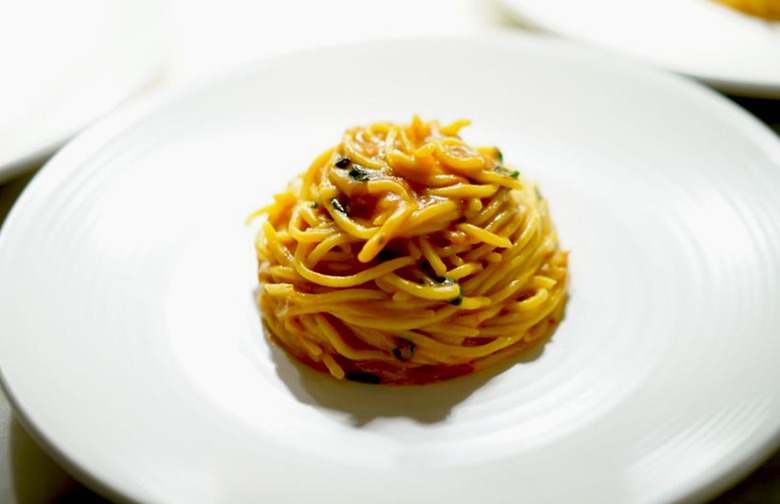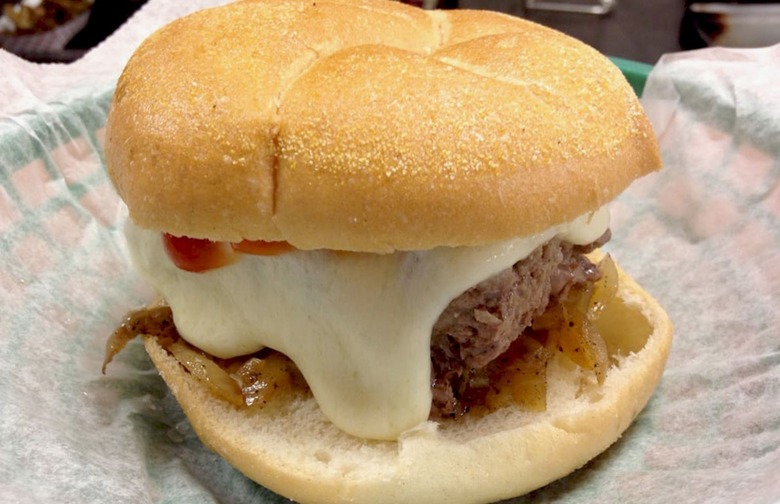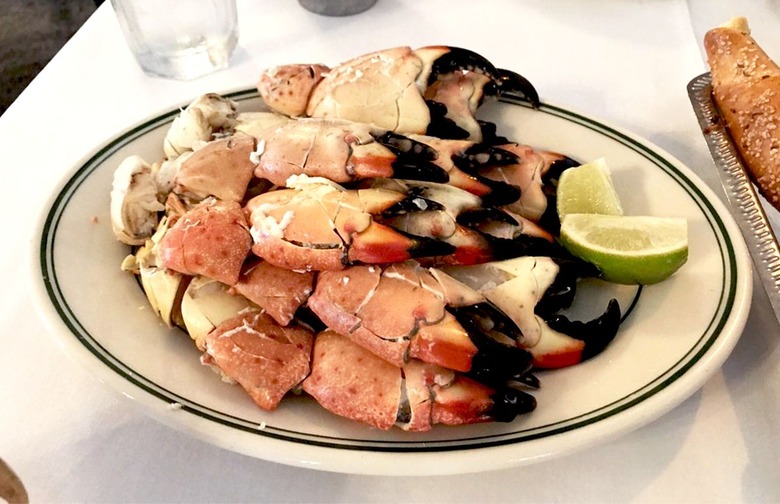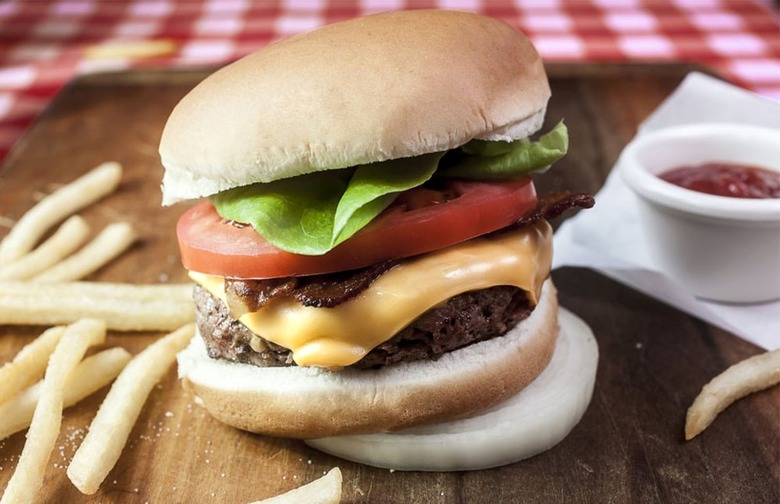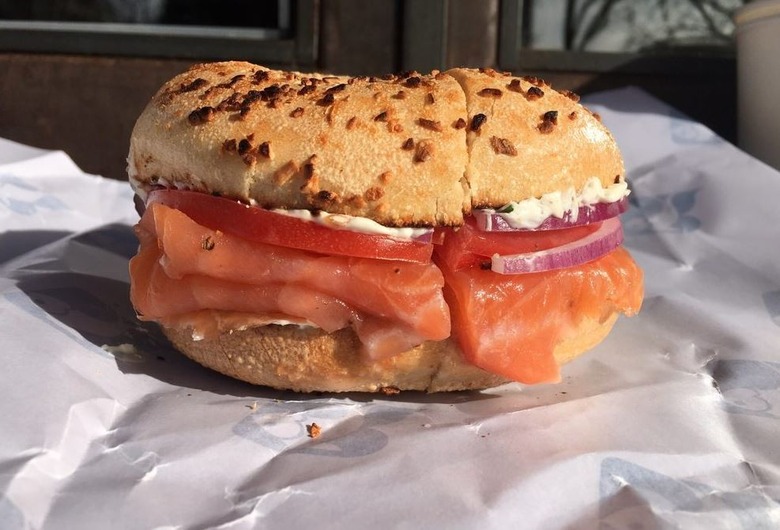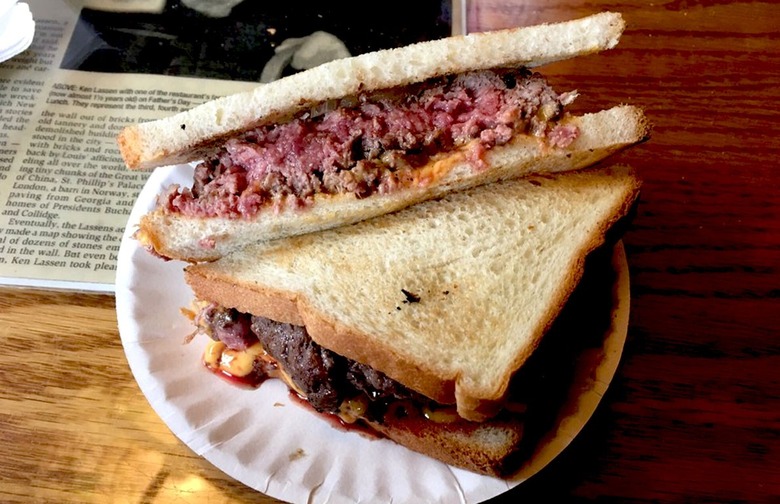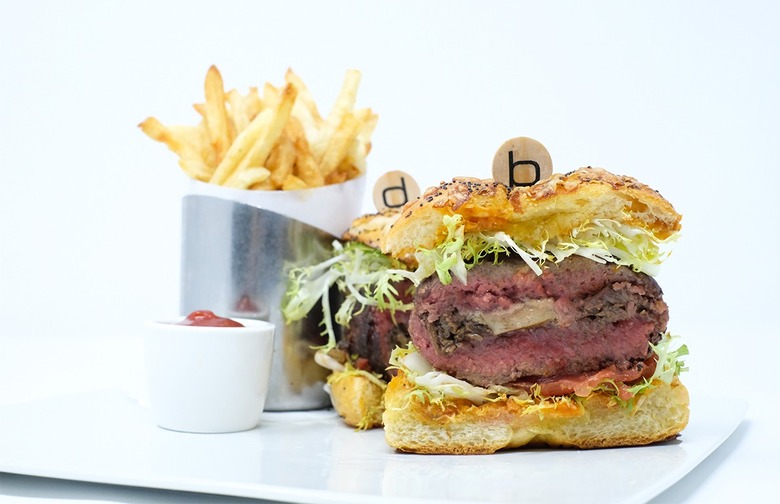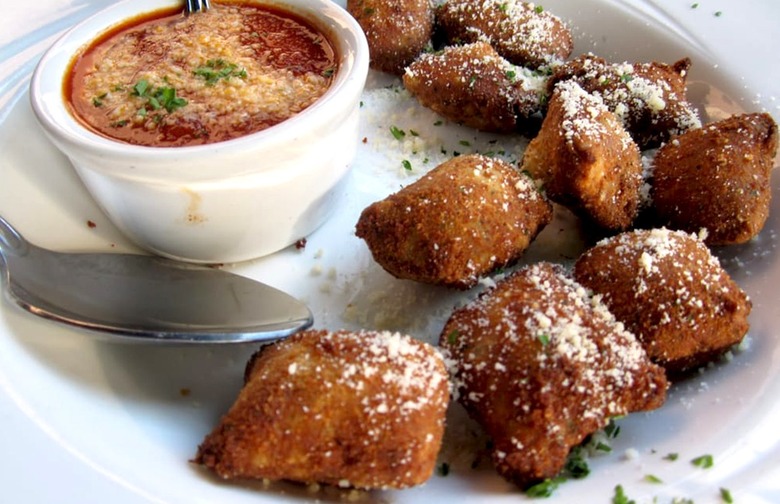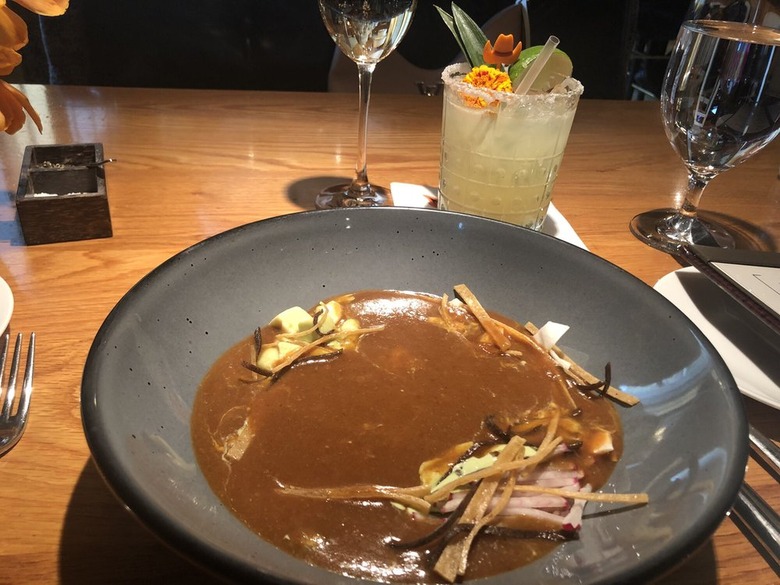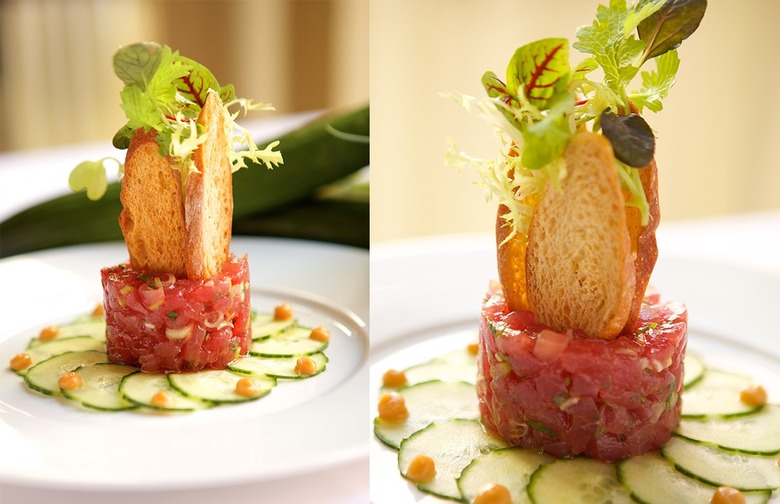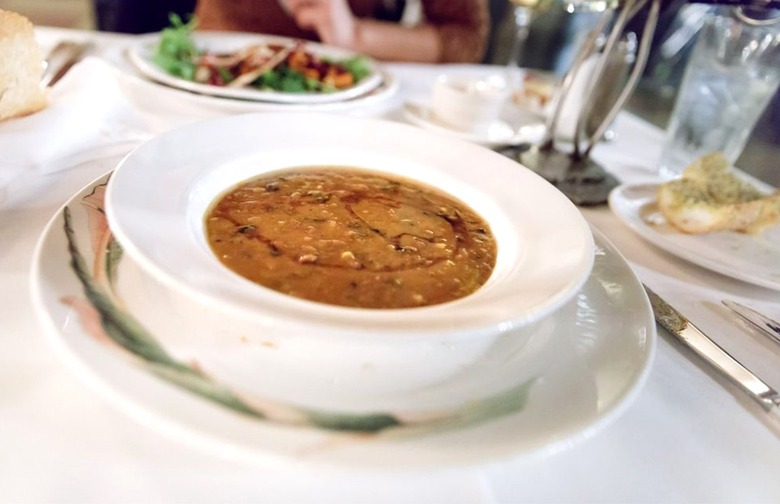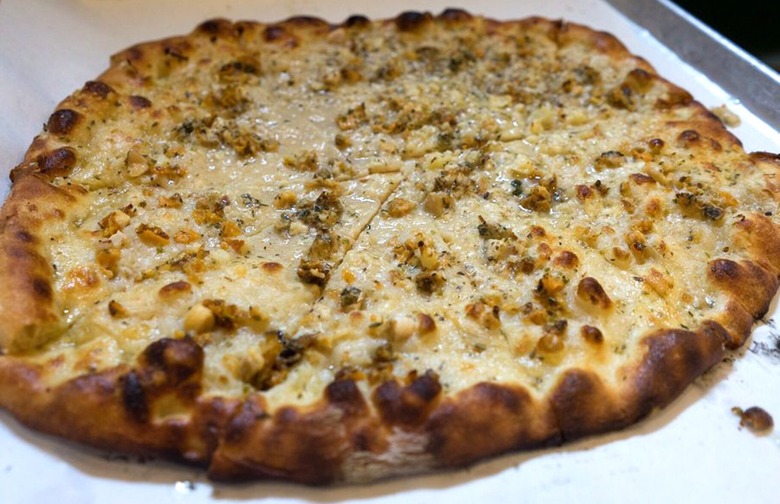The 101 Most Iconic Restaurant Dishes In America
Iconic dishes are the ones that we make pilgrimages for, the ones that are on the Great Foodie Bucket List, the ones that you can't leave a town without trying. They're the dishes that really are that good. In other words, they're dishes that you almost have to try at some point, and we've rounded up 101 of the most iconic dishes in America.
In order to limit our list to just 101 dishes, though, we had to set a few boundaries. One, all of these dishes are savory and can be considered an appetizer or main course, so no desserts (sorry, Cafe du Monde's beignets) or side dishes (sorry, Robuchon's pommes purée) are included. All of these dishes are also readily available in their most iconic form; for example, you won't find the Cobb salad from the Brown Derby on our list because that restaurant is long gone. Finally, in the interest of fairness, we didn't include dishes from major chains; there's no denying that the Egg McMuffin is iconic, but that's for a list of the most iconic fast food items of all time.
Our list truly runs the gamut of American dining, from legendary burgers, hot dogs, pizzas and fried chicken to lesser-known regional specialties; from dishes that go back more than a century to ones that have only been around for a decade but have accomplished a lot since then; from blue-collar classics whose inventors are long forgotten to fine-dining touchstones created by legendary chefs. These dishes tell the story of American dining through the years, and they're all undeniably iconic.
What makes a dish iconic?
So what, exactly, makes a dish iconic?
If it's been around for decades, if the definitive version is still served at the restaurant that created it, and if it's earned legions of loyal fans, then it might be an icon.
If it's so good that it's put the restaurant that serves it on the map and influenced others, it might be an icon.
If it's become so popular that it's now a household name, imitated (but never replicated) at countless other restaurants nationwide even as the restaurant that invented it is still going strong, it might be an icon.
If it's a rendition of a classic food, like fried chicken or pizza, that's considered to be so astoundingly delicious that pilgrims come from miles around to taste it, it might be an icon.
If it's the signature dish of one of the country's great fine-dining chefs, and a must-order at their restaurant, it might be an icon.
Clearly, the parameters are rather broad. But there's one thing all culinary icons have in common: You know it when you taste it.
Barbecue Plate, Franklin Barbecue (Austin, Texas)
Pitmaster Aaron Franklin and his wife Stacey started selling barbecue from an Airstream trailer in 2009, and today they're running one of the most highly praised restaurants in America, serving barbecue that's widely regarded as the very best you'll find anywhere at Franklin Barbecue in Austin, Texas. How did they get there? For one, attention to detail. The quality of the meat, the care and attention put into the seasoning, the wood, the smoking process and the carving... Franklin literally has it down to a science, and the crowds show up in droves every day to sample the fruits of his labor. Salt and pepper, meat, smoke and time are all that go into his brisket, ribs, pulled pork and turkey, and the end result is, well, perfect. You have to get there early and wait in line, but don't worry, this place is definitely worth waiting in line for.
Biscuits and Gravy, Loveless Café (Nashville, Tennessee)
In business since 1951, this legendary Nashville, Tennessee, restaurant Loveless Cafe serves what very well might be the best biscuits in the world, based on a recipe created by founder Annie Loveless herself and closely guarded to this day. If it's possible to improve on perfection, it's done by serving the biscuits alongside rich and creamy gravy. Thankfully, every breakfast plate is served with biscuits, so you don't have to miss out.
Black Cod With Miso, Nobu (Various Locations)
When chef Nobu Matsuhisa opened the first Nobu with pal Robert De Niro and restaurateur Drew Nieporent in New York's Tribeca neighborhood in 1994, there was no way he could have imagined that more than 20 years later he'd be running more than 30 affiliated restaurants around the world, as well as several Nobu-branded hotels. But there's a reason why Nobu has become a household name across the globe, as the menu fuses classical Japanese cuisine with influences from Peru and Argentina, where Nobu trained. The dish that Nobu (and his namesake restaurant) will be long remembered for is the often imitated, never replicated black cod with miso, which is marinated in white miso, sake, mirin and sugar for three days before being browned in a pan and finished in a hot oven. It's one of the planet's great fish dishes.
Black Label Burger, Minetta Tavern (New York, New York)
Sure, the côte de boeuf, roasted bone marrow and various ungodly delicious potato renditions are big reasons why Minetta Tavern is one of New York City's best restaurants for carnivores. But the Black Label Burger remains the most legendary item on the menu. Prime dry-aged beef, carefully sourced and aged for six to seven weeks, is well seasoned and given an enviable sear on a griddle before being nestled onto a sesame-studded brioche bun, topped with caramelized onions and served with pommes frites. Juicy, savory, salty, soul-satisfying... this is a burger unlike any other.
Blackened Redfish, K-Paul’s Louisiana Kitchen (New Orleans, Louisiana)
If you spent any time dining out in the '80s, you most likely encountered something that was blackened. You have chef Paul Prudhomme to thank for that, due to one revolutionary dish served at his K-Paul's Louisiana Kitchen in New Orleans, Louisiana: blackened redfish. The dish starts with a blend of spices including cayenne, paprika, garlic and onion powders, thyme and oregano, applied liberally to the Gulf fish before it's seared with a little clarified butter in a ripping-hot cast-iron pan. The dish was so popular, and became so ubiquitous nationwide, that it caused redfish to be fished to near-extinction. Today the dish is usually prepared with drum instead of redfish, but the best rendition is still served at K-Paul's.
Breaded Pork Tenderloin, Nick’s Kitchen (Huntington, Indiana)
In Iowa and Indiana, the humble pork loin is turned into one of the most delicious sandwiches you've never heard of but need to try, all thanks to some pounding and deep-frying. And this legendary sandwich was reportedly invented by Nick Freienstein nearly 110 years ago in the small Indiana town of Huntington; his restaurant, Nick's Kitchen, is still in business, and they're still using his recipe to turn out massive tenderloin sandwiches. A 4-ounce slice of lean center-cut pork loin is pounded down into a huge patty; marinated in buttermilk, eggs and flour; breaded in saltine crumbs; deep-fried; and served on a 5-inch hamburger bun with onion, lettuce and tomato. Imitators abound, but the original is still the best.
Buffalo Wings, Anchor Bar (Buffalo, New York)
Anchor Bar in Buffalo, New York, is the place that started it all, and many would argue that they've been often imitated, never duplicated. The wings are juicy, crispy, spicy and served to teeming hordes of hungry masses, and those who make a pilgrimage here never leave unsatisfied (especially after knocking back a few tap Genesee Cream Ales).
Burger, Father’s Office (Los Angeles, California)
When you go to Father's Office, chef Sang Yoon's gastropub in Los Angeles, California, you're most likely there for the Office Burger, which many people in LA refer to as the city's best and most iconic burger, and which helped to spark a burger renaissance upon its 2000 unveiling. It's a slab of high-quality beef topped with arugula, bacon, caramelized onion, Gruyère and Maytag blue on a loaf that's more similar to a baguette than a bun. It's a very, very juicy burger with funk, freshness and great flavor. Father's Office also has some of the very best french fries in America.
Burgoo, Stella’s Kentucky Deli (Lexington, Kentucky)
You might not have heard of burgoo, probably because it's still a regional Kentucky specialty that you'd be hard pressed to find outside of the state, but it's absolutely iconic. So when you're there, make sure you eat some of this thick, hearty soup loaded with meat and vegetables. The best place for burgoo is Lexington's homey Stella's, where it's made with beef, pork, chicken and lamb with corn, beans and other veggies, and is served with four mini corn muffins for sopping.
Canlis Salad, Canlis (Seattle, Washington)
Canlis is a true Pacific Northwest landmark. It's been open in Seattle, Washington, since 1950, serving fresh, seasonal dishes that are more polished than cutting-edge in a rustic-modern space whose use of native wood and stone evokes forests and streams. Canlis was revolutionary when it opened due to its stunning architecture and trailblazing menu of upscale Northwest cuisine (which founder Peter Canlis essentially invented), and it's still blazing new trails while keeping the classics, such as the famous Canlis salad (romaine, bacon, mint, oregano and Romano with a dressing of lemon, olive oil and coddled egg), on the menu.
Carnitas Burrito, La Taquería (San Francisco, California)
La Taquería is the most iconic burrito joint in San Francisco, the hometown of the now-ubiquitous Mission-style burrito. Either keep it simple and just stick with meat and beans — no rice filler in the burrito here — or upgrade it with all the classic burrito extras. We suggest you load yours up with their unique style of carnitas, which are somehow both crispy and moist, and incomparably delicious. All the praise that this perpetually packed institution receives is well worth it: It really is that good.
Charbroiled Oysters, Drago’s Seafood Restaurant (Metairie, Louisiana)
Gulf oysters from Louisiana are some of the plumpest and tastiest in the country, and they're insanely plentiful. Sure, you can eat them raw on the half-shell, but why not head to Drago's, where they're shucked, placed on a fiery grill, and doused with a heady mixture of butter, garlic, oregano, Parmesan and Romano cheeses and parsley as they cook? This is one of those quintessential tastes of the New Orleans area. If you can't make it out to Metairie, there's a second location in Downtown NOLA.
Cheese Slice, Joe’s Pizza (New York, New York)
Since 1975, Joe's Pizza has served fresh, hot, cheesy slices to tourists and residents alike, making it a truly iconic New York City landmark. It's as synonymous with New York City as the Statue of Liberty or the Empire State Building. Everyone has a favorite slice joint, but if the city were to have just one, this would be it. It's made every conceivable best-of list (many of them tacked on the walls and in the windows), and for good reason. The key to Joe's success is their traditional New York City-style pizza with thin crust, great sauce and just the right ratio of cheese, sauce and crust (just a bit less of the first two).
Cheeseburger, Husk (Charleston, South Carolina)
So what's the secret to the burger at Charleston, South Carolina, must-visit Husk? There are several: Bacon is ground right into the patty, for one, and house-made buns are steamed, sliced, toasted and smeared with butter and beef fat. The two patties are a blend of chuck and hickory-smoked Benton's bacon, seared on a ripping-hot nonstick griddle and scraped off to retain their crust. Three slices of American cheese, shaved white onions in between the patties, bread-and-butter pickles, a "special sauce" that closely resembles the one at In-N-Out, lettuce and tomato only when they're in season round it out. The restaurant has expanded beyond Charleston into Nashville, Greenville and Savannah, and the burger is definitely one of the (several) reasons for its success.
Cheesesteak, Pat’s King of Steaks and Geno’s (Philadelphia, Pennsylvania)
On the intersection of South Ninth Street, Wharton Street, and East Passyunk Avenue in South Philadelphia are two cheesesteak giants: Pat's and Geno's. They both have a fiercely loyal clientele, each of which will tell you that their favorite is superior. Pat's claims to have invented the cheesesteak as we know it: As the story goes, in May 1933 brothers Pat and Harry Olivieri, who owned a hot dog stand on the corner, thinly sliced a steak and fried it with onions, and a legend was born.
Pat's and Geno's serve a similar product (with both using thinly sliced rib-eye steak), but there's one main difference: Pat's chops up its meat while it's on the grill, and Geno's keeps its slices whole. Which one you order comes down to personal preference, but just make sure you learn the lingo first — "wit" means with onions, "wit-out" means without onions — and know which kind of cheese you want (Cheez Whiz, provolone, American, mozzarella or none) before you start your order.
Chicago-Style Hot Dog, Superdawg (Chicago, Illinois)
Topped by what has to be some of America's best signage — a flexing hot dog showing off his muscles to a winking wiener girl — Superdawg has been a Chicago institution since the adorably named husband-and-wife duo of Maurie and Flaurie Berman opened it in 1948. The family-owned restaurant still serves superior pure beef dogs, topped in the traditional Chicago style with yellow mustard, relish, diced onions, a pickle, celery salt, a sport pepper and a pickled green tomato (a welcome tweak from the usual red).
Chicken and Waffles, Roscoe’s House of Chicken and Waffles (Multiple Locations in California)
This Roscoe's House of Chicken and Waffles, which first opened in Hollywood, has been serving up fried chicken and waffles since 1975 — when the owner, Harlem-bred Herb Hudson, brought some recipes from home to the West Coast — and has since expanded into a small local chain of restaurants. The chicken is fried fresh to order, and make sure to ask for your waffles to be cooked extra-crispy.
Chicken for Two, Zuni Café (San Francisco, California)
The late chef Judy Rodgers made waves in San Francisco when she introduced roast chicken to the menu after taking over Zuni Café in 1987. Her chicken (which is still the restaurant's top seller) starts with a dry brine before being dried, seasoned and cooked in a very hot oven. It's served over a warm salad of arugula and chunks of bread, and there's still no other dish quite like it.
Chili Dog, Martinsville Speedway (Ridgeway, Virginia)
Eating a chili dog at the Martinsville Speedway is a rite of passage for racecar drivers and fans alike, and this iconic frankfurter also happens to be one of the best hot dogs in America. Over one weekend, more than 50,000 of the hot dogs are sold, and at just two bucks a pop, they're a steal. These dogs have been served for more than 60 years in the same way: a soft bun, slaw, cheese, hand-chopped onions and a secret-recipe chili, wrapped in waxed paper. When the speedway switched hot dog suppliers (for the first time in nearly 70 years) from Jesse Jones to Smithfield-owned Valleydale Foods a few years ago, there was a major uproar, but even die-hards say they can't tell the difference.
Chopped Barbecue Sandwich, Lexington Barbecue (Lexington, North Carolina)
It's all about the pork when it comes to "Lexington-style" North Carolina barbecue, and though countless restaurants are serving their take on smoked pork shoulder sandwiches, none quite compare to Lexington Barbecue, going strong since 1962. You can order yours sliced or chopped (we prefer chopped), but make sure you don't skimp on the slaw, a tangy mix of cabbage, vinegar and pepper. It's a smoky, porky, perfect expression of just one of America's distinctive regional barbecue styles.
Chorizo-Stuffed Medjool Dates, Avec (Chicago, Illinois)
Chef Paul Kahan is one of Chicago's most legendary and prolific chef-restaurateurs, and his Avec, with its wide variety of Mediterranean-inspired small plates, fills to capacity within minutes of opening every day. There's one dish that's to be found on nearly every table, and it's one that's been on the menu since the day Avec opened in 2003: bacon-wrapped, chorizo-stuffed dates. To make this dish, medjool dates are stuffed with (and encased inside) fresh chorizo, wrapped in thick-cut bacon, cooked in a hot wood-burning oven,and served in a pool of piquillo pepper-tomato sauce alongside a fresh ciabatta. It's sweet, salty, smoky, fatty and an absolute must-order.
Cioppino, Tadich Grill (San Francisco, California)
The word may sound Italian, but cioppino is an American dish invented by Genoese immigrant Giuseppe Bazzuro in the 1950s, and one of San Francisco's most iconic foods. Tadich Grill, one of the city's oldest restaurants, serves the definitive version: a heady and luxurious tomato-based stew brimming with fresh local seafood including Dungeness crab, shrimp, halibut and scallops. It's the most popular item on the menu here for a reason.
Clam Chowder, Union Oyster House (Boston, Massachusetts)
The Union Oyster House is Boston, Massachusetts' most famous restaurant, and its New England clam chowder is the definitive version, hands-down. It starts (as all great clam chowders do) with diced salt pork, which is rendered down and combined with butter, flour, onion and celery to form a roux. It's combined with house-made clam juice, half-and-half, chopped fresh clams, a couple dashes of Tabasco and diced potatoes. The end result is thick, creamy, simple and perfect.
Classic Chili, Barney’s Beanery (Los Angeles, California)
The nearly 100-year-old Los Angeles institution Barney's Beanery was opened by John "Barney" Anthony, whose chili and onion soup recipes made him popular among his fellow troops during World War I. What started as a small wooden shack on Santa Monica Boulevard soon became a favorite among Hollywood's elite, and today there are six locations in the Los Angeles area. There are five chili varieties available: classic, Texas-style, turkey, fireman's and vegetable, but if you try one, make it the classic, with a recipe dating back to 1920: It's full of ground beef and beans, and it's a timeless classic, just like Barney's.
Conch Chowder, Conch Republic (Key West, Florida)
Key West may also be known as the Conch Republic, but there's only one restaurant on the island that's earned the right to carry the name. Conch Republic Seafood Company is located on the historic Key West Bight Marina, and they do their conch right. You can order it flash-fried or as fritters, but you'll also want to try it in their homemade conch chowder, a Bahamian-style red chowder made with ground conch, herbs and potatoes that's become an iconic dish in these parts. It's something no visitor to Key West should leave without trying.
Coney, American Coney Island and Lafayette Coney Island (Detroit, Michigan)
In Detroit, there's an epic rivalry going back decades between two neighboring hot dog stands — American Coney Island and Lafayette Coney Island — and both are equally legendary and have legions of loyalists. Both have been open for many decades (American is over 100 years old, but a semi-recent renovation made it not quite as grungy as Lafayette, for better or worse), and both serve classic coneys: Natural-casing hot dogs get placed into a warm steamed bun, then topped with a Greek-spiced, beef-heart-based chili sauce, a heap of diced onions and a squirt of mustard. No trip to Detroit is complete without a coney dog, and we suggest you visit both of the most iconic vendors.
Cuban Sandwich, Versailles (Miami, Florida)
The Cuban sandwich is one of the many dishes you may not realize were invented in America. It actually originated in Florida, not Cuba, and in many ways it's the unofficial sandwich of Miami. Just about all Miami Cuban sandwiches contain the same ingredients — ham, roast pork, Swiss cheese, pickles and mustard on Cuban bread, pressed until melted — but quality can vary from place to place. The definitive version can be found at Versailles, located in Miami's Little Havana. Fresh Cuban-style white bread loaves are baked in house; ham is glazed with brown sugar, pineapple juice and cloves before being baked; whole pork legs are marinated and slow-roasted for three hours daily; and imported Swiss cheese is sliced thick. A good Cuban sandwich depends on the quality of its ingredients, and the ingredients in Versailles' version are just about perfect.
Deep-Dish Pizza, Pizzeria Uno (Chicago, Illinois)
Uno founders Ike Sewell (a Texan and All-American footballer) and Ric Riccardo first planned to serve Mexican food at their Chicago, Illinois, restaurant, but eventually they settled on a more substantial version that Sewell had envisioned. After some trial and error, deep-dish pizza was born, and you can still sample the original creation at the place of its birth. Some argue that the deep-dish served at Lou Malnati's, Pequod's and other competitors might be better, but there's something to be said about a pilgrimage to the original to try one of America's most iconic pizzas.
Detroiter, Buddy’s Pizza (Detroit, Michigan)
Detroit-style pizza has been catching on outside of the Motor City in recent years, and for a very good reason: It's like a Sicilian slice on steroids, with a crisp, light yet thick crust, plenty of sauce and cheese and a satisfying crunch from double-baking double-stretched dough in a cast-iron pan. You can find this style all throughout Detroit (and even as far afield as New York City), but it all started at Buddy's, which invented the style more than 70 years ago and still is widely regarded as serving the best around. Go for the classic Detroiter, which is topped with pepperoni.
Dick’s Deluxe, Dick’s (Seattle, Washington)
Dick's is a Seattle, Washington, institution. Since 1954, they've served burgers, hand-cut fries and milkshakes, and the owners know that if it ain't broke, they shouldn't fix it. The Deluxe is an ideal burger: two fresh-ground 1/3-pound patties, melted cheese, lettuce, tomato and pickle relish, on a soft, freshly baked bun. This burger makes Dick's one of America's classic drive-ins that are still worth pulling up to.
Egg Caviar, Jean Georges (New York, New York)
Jean-Georges Vongerichten is one of the best chefs in America, and the egg caviar is the most famous dish at his flagship New York restaurant, Jean Georges, and one of New York's most iconic fine-dining bites. To make the dish, heavy cream is lightly whipped with cayenne, salt and a touch of vodka and fresh lemon juice, and the mixture is added into a piping bag. Egg, salt, cayenne, cream and butter are whisked into a very soft scramble, and this mixture is spooned into the bottom of an eggshell. It's then topped with the vodka whipped cream and a massive spoonful of caviar. If this isn't fine dining, we don't know what is.
Eggs Benedict, Delmonico’s (New York, New York)
Eggs Benedict is the quintessential brunch dish, a perfect pile of English muffin, Canadian bacon, poached egg and hollandaise. You can find versions of varying quality on any brunch menu worth its salt, but only one restaurant can make a credible claim to having invented it: Delmonico's, in business since 1860 in Lower Manhattan. Supposedly invented here for regulars Mr. and Mrs. LeGrand Benedict in the late 1800s, the version served at the fancy steakhouse today, with thick-sliced ham, luxuriously creamy hollandaise and a dab of caviar, is essentially perfect.
French Dip, Philippe the Original (Los Angeles, California)
Countless restaurants serve French dip sandwiches, but the definitive version can still be found at the restaurant where it was invented: Los Angeles' Philippe the Original. Because it's been around for 105 years, the exact origins of the sandwich are disputed. (The most commonly held belief is that it was created as a way to soften up day-old bread, but nobody knows where the "French" part came from.) However, the process behind this masterpiece is no mystery: Bottom round is seasoned with salt, pepper and mashed garlic, slow-roasted with a mirepoix until medium-rare, and sliced and placed onto a fresh French roll from a local bakery that's been dunked into jus made with homemade stock and the intensely flavored pan drippings.
Fried Calamari, Randazzo’s Clam Bar (Brooklyn, New York)
If you've ever eaten fried calamari, you have a legendary seafood restaurant in Brooklyn's waterside neighborhood of Sheepshead Bay to thank for that. Back in 1960, when the dish was popularized by Randazzo's Clam Bar owner Helen Randazzo, calamari was very unpopular in North America; squid was usually used as bait and only sold for a couple cents per pound. But Randazzo had the idea to slice it into bands, bread and fry it, and serve it for free at the bar alongside some of her (still-)famous tomato sauce. The rest is history.
Fried Chicken, Gus’s World Famous Fried Chicken (Mason, Tennessee)
Founded in 1953 in Mason, Tennessee, a small town about 40 miles outside of Memphis, Gus's has since expanded to 28 locations across the country. The chicken recipe can trace its roots back to the restaurant's founders, Na and Maggie Vanderbilt, and their son, Gus Bonner. To make this chicken, buttermilk-coated chicken pieces are dredged in flour, paprika, cayenne, salt and black pepper before being fried in a cast-iron skillet, and the resulting bird is crispy, juicy, spicy and addictively delicious.
Fried Chicken, Willie Mae’s Scotch House (New Orleans, Louisiana)
You haven't truly had fried chicken until you've had it from Willie Mae's, the legendary restaurant located in New Orleans' Treme neighborhood since 1956. Look around the two no-frills dining rooms and you'll see nothing but fried chicken, even though there are theoretically other offerings, like smothered veal, on the menu. But if it's your first time there, take a cue from the regulars and pilgrims alike. The wet-battered chicken, perfected by Willie Mae Seaton (who passed away in 2015 at age 99) and today safeguarded by her granddaughter Kerry, is, simply put, otherworldly. Fried to order, the crust is shiny, craggy, light, not greasy, and shatteringly crisp and crunchy. Underneath, the chicken is impossibly moist and juicy.
Frita Cubana, El Mago de las Fritas (Miami, Florida)
The frita is a perfect representation of the American influence on Cuban culture, and vice versa. It was created in Cuba and brought over to the States after the revolution, and the one served at Little Havana's El Mago de las Fritas is arguably the best. Here's the breakdown: A fresh-ground patty of spiced beef (possibly with some chorizo mixed in) is pressed flat onto the griddle along with some diced onions and a mysterious red sauce, then tucked into a fresh Cuban roll. It's topped with freshly fried potato sticks (not from a can here, as they are at some other places), more diced onion and a squirt of ketchup.
Fusilli With Red Wine Braised Octopus and Bone Marrow, Marea (New York, New York)
When it opened, Marea was immediately acclaimed as one of the most original and consistently wonderful upscale Manhattan restaurants. And it's still a must-visit, with two dishes that are so unique and wonderful that they've officially entered New York's culinary canon: a simple crostini with sea urchin and lardo, and fusilli with octopus and bone marrow. The latter, chef Michael White's homage to surf and turf, starts with house-made durum wheat fusilli. This is tossed with a sauce of braised baby Spanish octopus, sangiovese wine, San Marzano tomatoes, garlic, basil and chunks of lightly sautéed bone marrow before being plated and topped with toasted bread crumbs. This dish remains in a league of its own in the competitive New York dining scene.
Garbage Plate, Nick Tahou’s Hots (Rochester, New York)
Insanely popular in the Rochester, New York, area but little-known outside of it, the garbage plate gets its name because of the huge quantity and variety of food piled onto a plate. Widely credited with being created at a restaurant there called Nick Tahou's Hots, it's prepared by starting with either baked beans or macaroni salad, then piling on home fries or french fries. It's then topped with your choice of two of the following: hamburger, cheeseburger, Italian sausage, red hot or white hot (local hot dog variations), chicken tenders, haddock, fried eggs, ham or a grilled cheese. Then it's topped with onions, mustard and beef chili sauce. It's a certifiable hangover buster, and a dish you'll only find in the Northeast.
Gerber, Ruma’s Deli (St. Louis, Missouri)
Popular in and around St. Louis, Missouri, the Gerber is an open-faced sandwich made with a loaf of Italian or French bread that's topped with garlic butter, ham, provel or provolone, and paprika, then toasted, and nobody does it better than the place where it was invented, family-owned Ruma's Deli. The cheese and garlic butter melt, the whole thing gets brown and bubbly, and it's simple and delicious.
Gnocchi, Spiaggia (Chicago, Illinois)
Chef Tony Mantuano's refined and modern Spiaggia is the gold standard for Italian fine dining in Chicago, and it's constantly breaking new ground and reinventing itself, most notably with a 2014 renovation and menu revamp. There's one dish, however, that can never be removed from the menu or it might incite riots (or at least polite disapproval): the gnocchi. Super-tender hand-rolled gnocchi are blanched and tossed in a sauce made with heavy cream, milk, ricotta and a handful of Parmigiano-Reggiano and a drizzle of truffle oil (the real stuff, infused with preserved Italian truffles). It's plated after the sauce reduces slightly, and it's topped with a spoonful of rich jus and a couple of those preserved sliced truffles. It's a masterpiece and a must-order, even with a $40 price tag.
Goat Cheese Salad, Chez Panisse (Berkeley, California)
A salad of mixed greens topped with a crispy puck of breadcrumb- and herb-coated goat cheese is so ubiquitous a dish — and has been since the 1980s — that most people don't even realize that it was invented by Alice Waters at her seminal Berkeley restaurant, Chez Panisse, in 1981. Back then, fresh goat cheese was incredibly difficult to come by, and Waters had the ingenious idea to bake it in a crisp crust until warm and slightly melted. It's still on the menu at the upstairs café, as it has been since day one.
Green Chile Stew, The Shed (Santa Fe, New Mexico)
Going strong since 1960, The Shed is one of Santa Fe's most renowned restaurants, and quite possibly the best place in the state to get your fix of dishes prepared with New Mexico's famed Hatch chiles. While the posole is also spectacular, the green chile stew is the one to order; made with roasted chiles, potatoes and chunks of lean pork, it's everything that's great about New Mexican cuisine in one iconic bowl.
Gumbo, Dooky Chase (New Orleans, Louisiana)
Dooky Chase is one of New Orleans' most legendary restaurants, largely thanks to its legendary chef and proprietor, Leah Chase. Her gumbo is the platonic ideal of this Creole classic, made with a dark roux and loaded with shrimp, Creole sausage, smoked sausage, beef, ham, oysters and chicken wings. It's thickened with file powder instead of okra, and even the most serious of the city's gumbo connoisseurs will tell you that hers is the best around. Chase recently passed away, but thankfully, her children and grandchildren picked up right where she left off.
Half-Smoke, Ben’s Chili Bowl (Washington, D.C.)
The celebrity (and presidential) photos on the wall are clear indications of Ben's Chili Bowl's Washington, D.C., landmark status, but the continuous lines out the door are evidence that the restaurant's chili cheese dogs are some of the best in the country. But those in the know don't just order "dogs," they get the half-smokes, a half-pork, half-beef smoked sausage, which is a native D.C. specialty supposedly invented by Ben Ali, the original proprietor, whose sons took over the restaurant after his death. As the U Street Corridor/Shaw neighborhood around it has gentrified, Ben's remains a more-than-50-year-old bastion of down-home D.C. where college kids, old-timers and celebrities are all welcome, as long as they're willing to stand in line like everybody else.
Hickory Burger, The Apple Pan (Los Angeles, California)
This standalone counter-only burger-and-pie place in West Los Angeles hasn't changed since it opened in 1947 (well, except for the prices). The Apple Pan's signature Hickory Burger is a juicy round of hickory-smoked ground beef on a standard bun anointed with mayonnaise and a secret sauce that tastes like slightly spiced-up ketchup. Pickles and lettuce complete the package, with Tillamook cheddar melted on top for an extra 50 cents. It might sound like nothing special, but we assure you, it is.
Hickory Smoked BAR-B-Q Chicken, Big Bob Gibson (Decatur, Alabama)
Chris Lilly is one of America's most renowned barbecue pitmasters, and with good reason. He took over the pit at the circa-1925 Big Bob Gibson a couple of decades ago, introducing new sauces and rubs to the equation, and suddenly the restaurant was on the map. He's best known for his Alabama-style white sauce, a tangy concoction that best complements his smoked chicken, and since its introduction it's become one of America's most iconic barbecue and chicken dishes. Half-chickens are smoked low and slow over hickory, and dunked in a zippy mayo-based sauce before serving.
Horseshoe, D’Arcy’s Pint (Springfield, Illinois)
If you don't know what a horseshoe sandwich is, you can be forgiven: It's a dish that's native to Springfield, Illinois (invented there at the now-closed Leland Hotel in 1928), and not so easy to find outside of it. A relative of the Rochester garbage plate, it's an open-face sandwich that starts with thick-sliced toast, which is then topped with your choice of meat (usually ham, a burger patty, turkey, bacon, grilled chicken, Italian sausage, pork tenderloin or walleye), fries and a huge ladle of cheese sauce. You can find it at a bunch of restaurants in town, but an Irish pub called D'Arcy's Pint serves a version with crinkle-cut fries and a top-notch cheese sauce.
Hot Brown, Brown Hotel (Louisville, Kentucky)
The Hot Brown is Kentucky's most legendary culinary contribution, invented in 1926 by Fred K. Schmidt, chef at Louisville's luxurious Brown Hotel. The hotel is still going strong, and the best place to enjoy this renowned open-faced sandwich is at its point of origin. (It's served at the hotel's three restaurants and in-room dining.) To make the definitive version of this classic dish, toast is topped with sliced turkey and doused in a creamy pecorino-based Mornay sauce before being browned in the broiler. Crispy bacon and sliced tomatoes round it out.
Hot Dog, Gray’s Papaya (New York, New York)
The classic New York hot dog comes in many forms, but they're almost always made by one company: Sabrett. Gray's Papaya has two New York locations, and these colorful purveyors of old-school New York character grill their natural-casing Sabrett dogs on a flat-top, nestle them inside a lightly toasted bun, and top them with mustard, sauerkraut or the classic "onions in sauce," also made by Sabrett. Lean up against the ledge and do some people-watching, wash down a couple dogs with some "papaya drink," and be on your merry way, full, content and out only a few bucks.
Hot Dog, Nathan’s Famous (Brooklyn, New York)
The most famous hot dog stand in the country is still one of the best. A trip to the original Nathan's stand in Brooklyn's Coney Island is a pilgrimage that everyone should make at least once. Stand in the same line that millions of others have over the years, place your order, and snap into the perfect embodiment of a summer day: the sea, the boardwalk and an original Nathan's hot dog. There's nothing else like it.
Hot Potato, Cold Potato, Alinea (Chicago, Illinois)
The most famous dish at Alinea, chef Grant Achatz's Chicago flagship and modernist utopia, Hot Potato Cold Potato toys with the senses by pairing hot with cold, turning familiar flavors on their head. Hot potato-truffle soup is poured into a small custom-made paraffin bowl, which allows a pin containing a cold truffle-topped ball of potato and cubes of Parmesan cheese and butter to hover over it, suspended on the pin. When the pin is removed, the cold potato drops into the hot potato, creating a mind-blowing sensory experience. It's easily the most famous "molecular gastronomy" dish that's not affiliated with Ferran Adrià.
Hot Weiner, Olneyville New York System (Providence, Rhode Island)
Olneyville New York System, with two locations in Providence, Rhode Island, claims to serve "Rhode Island's Best Hot Wieners," and while that will always remain a point of contention, they're certainly the most legendary. The New York System dog is a regional specialty: Small franks are steamed, placed atop a steamed bun, and topped with a cumin-heavy meat sauce, yellow mustard, diced onions, and celery salt. You're going to want to order a few of these, because they're little and addictive (see how many of them the counterman can balance on his arm).
Italian Beef, Al’s #1 Italian Beef (Chicago, Illinois)
Way back in 1939, Al's #1 Italian Beef started as a small food stand, later morphing into an iconic Chicago franchise with 8 Chicagoland locations. During the Depression, owner Al Ferrari and his family began slicing roast beef very thin and placing it on small fresh loaves of Italian bread, unintentionally creating a legendary sandwich. To make this beauty, sirloin is rubbed with a secret spice blend, dry-roasted, thinly sliced, made into a sandwich and then dunked in Al's signature "gravy" (more similar to au jus). Customers can choose how much or little they want, but Al's encourages customers to get their sandwiches "wet." When topped with the signature giardiniera, a tart and spicy pickled vegetable blend, this sandwich is a masterpiece.
Jucy Lucy, Matt’s Bar (Minneapolis, Minnesota)
Ah, the legendary Jucy Lucy. While the battle rages between Matt's Bar and the nearby 5-8 Club over who invented this brilliant burger variation (basically a cheeseburger with the cheese inside the patty instead of on top), the one at Matt's Bar is the superior specimen. Legend has it that shortly after the restaurant opened in 1954 a hungry customer came in and asked for two burger patties with a slice of cheese in the middle. He took a bite, proclaimed it to be "one juicy Lucy!" — and an icon was born. Only fresh-ground beef goes into each hand-formed burger, and the first bite yields a river of molten, gooey cheese. These burgers are much more difficult to make than it may appear, and the one at Matt's Bar is absolute perfection.
Knoephla Soup, Kroll’s Diner (Bismarck, North Dakota)
If the word "knoephla" doesn't ring any bells, then you probably haven't been to North Dakota, and you definitely haven't been to Kroll's Diner, a German-influenced institution that's been a local favorite since 1972. So what is knoephla? It's a thick and creamy chicken and potato soup that can trace its roots to Germany, and in North Dakota, Kroll's does it best.
Kung Pao Pastrami, Mission Chinese Food (New York, New York, and San Francisco, California)
Chef Danny Bowien's Mission Chinese Food, which originated in San Francisco and today has additional locations in Manhattan and Brooklyn, just might be the most fun and exciting "Asian fusion" restaurant in America. Bowien takes traditional Chinese cuisine and turns it on his head, and his wildly iconoclastic ethos is perhaps best exemplified by his most iconic dish: Kung Pao Pastrami. The dish has many traditional Chinese elements — Shaoxing wine, Tianjin chiles, ginger, Sichuan peppercorns, broad bean paste — but it's the addition of potatoes and big chunks of pastrami that make this dish unlike any other. It's spicy, smoky and completely original, and it's become a culinary icon. It's made Bowien one, too.
Lasagna, Consiglio’s (New Haven, Connecticut)
This old-school Italian joint has been a New Haven, Connecticut, legend since it opened nearly 80 years ago, and Consiglio's is still going strong on Wooster Street today. All the red sauce staples are represented here, but it's the lasagna that the locals swear by. Pasta sheets, ground beef, ricotta cheese and tomato sauce are layered, and it's all baked with a melty topping of mozzarella. It's lasagna perfection.
Lavender and Honey Duck, Eleven Madison Park (New York, New York)
Eleven Madison Park is one of the world's great restaurants, and its kitchen is led by the incomparable chef Daniel Humm. Its menu has gone through many incarnations since Humm and (now-former) business partner Will Guidara took it over from Danny Meyer in 2011, but Humm's signature dish, Lavender and Honey Duck, won't be going anywhere any time soon. To make this dish, ducks are aged for at least 10 days, trussed, rubbed down with honey, lavender, cumin, coriander and Sichuan peppercorns, roasted and presented with a bouquet of lavender before being carefully carved and plated with a drizzle of sauce alongside seasonal garnishes and confited legs.
Lobster Roll, Red’s Eats (Wiscasset, Maine)
The line is long and the wait begins in your car on the one-lane lead-up to Red's Eats and the bridge. It hasn't endeared tourists to locals, but that wait will definitely be worth it: This is the most famous, most iconic, and quite possibly the best lobster roll on Earth. The roll itself is heaping with fresh, wet lobster — so much it falls all over. It tastes just-cooked and -picked, and it's a great deal. Get butter (warmed in a kettle on the stove) and mayo on the side. Put simply, it's lobster roll perfection.
Loco Moco, Rainbow Drive-In (Honolulu, Hawaii)
This Hawaiian staple, invented in the late 1940s at a long-gone restaurant called the Lincoln Grill, is one of the most comforting dishes you'll find anywhere, and makes for a great late breakfast after a morning of surfing. It starts with a foundation of white rice, which is then usually topped with a hamburger patty or two, fried eggs and brown gravy. It's open to interpretation, however, and the burger patties can be replaced with anything from bacon and Spam to chili, kalua pork and shrimp. The definitive version can be found at Honolulu's legendary Rainbow Drive-In, which has been serving it to hungry locals and tourists alike since 1961.
Loose Meat, Taylor’s Maid-Rite (Marshalltown, Iowa)
An Iowa staple that's a true Midwestern regional specialty, the "loosemeat" sandwich (also called a tavern sandwich) can be thought of as a sloppy Joe without the sauce: crumbled seasoned ground beef on a bun, topped with mustard, pickles and chopped onions. Even though you can find it in plenty of small local restaurants, the one to visit is Taylor's Maid-Rite in Marshalltown. Going strong since 1928, it's a truly historic institution, as the loosemeat sandwich really is one of those dishes that you'll only find in the Midwest.
Matzo Ball Soup, Second Avenue Deli (New York, New York)
There are countless great bowls of soup in New York, and even when you narrow it down to matzo ball soup (the hands-down signature soup of the Big Apple), the restaurants serving very good versions easily number in the dozens. But for the quintessential bowl of matzo ball soup in New York City, go to the Second Avenue Deli. Big stockpots of the stuff are kept simmering in the kitchen throughout the day, and every detail is on point: the broth is crystal clear and rich with chicken flavor, the matzo balls are light and buoyant thanks to the deft hand of the cooks, and the tableside addition of tiny noodles, carrots and dill brings it all together.
Mole, Guelaguetza (Los Angeles, California)
With the 1994 opening of Guelaguetza, the Lopez family introduced Los Angeles to authentic Oaxacan cuisine. Now the number of local Oaxacan restaurants trails only those of Mexico City and Oaxaca itself, and much of that can be attributed to the success of this Koreatown spot. Named for Oaxaca's famous traditional summertime festival, Guelaguetza is a year-round destination for its tamales, memelas (chubby cornmeal cakes similar to sopes), unstuffed enchiladas and, of course, exquisite moles. Six moles are on the menu here, ranging from the dark and intoxicating mole negro to the bright mole verde, and each is a dish unto itself, with dozens of ingredients and hours of labor required to make each one. Guelaguetza, and its moles, showed Angelenos, and America at large, what Mexican food could be.
Muffuletta, Central Grocery (New Orleans, Louisiana)
If you're in New Orleans and looking to try the definitive version of this legendary cold cut sandwich, follow the crowds and head to the place that invented it: Central Grocery. Sliced genoa salami, mortadella, ham and provolone are layered onto a distinctive round loaf; the bottom loaf is brushed with olive oil, and the top gets a couple spoonfuls of proprietary "olive salad" before the giant sandwich is sliced into wedges.
Mutton Chop, Keens Steakhouse (New York, New York)
Since 1885, this New York institution Keens Steakhouse has done one thing, and done it really, really well: meat. Perfectly charred steaks and chops are served in this labyrinthine shrine to old New York, which is spread over two floors and three townhouses. Before you're served your expertly cooked, gigantic, dry-aged sirloin, filet mignon, prime rib, porterhouse for two, or porterhouse for three, have a look around. There's memorabilia from more than 100 years of New York history, including playbills, political cartoons and photographs, as well as a collection of more than 50,000 pipes from back when regulars, including Babe Ruth and Teddy Roosevelt, would store theirs there. If you want to try the most iconic dish on the menu, however, make it the famous mutton chop, a 26-ounce lamb saddle that's nearly 2 inches thick and dates back to the restaurant's earliest days.
Nashville Hot Chicken, Prince’s Hot Chicken Shack (Nashville, Tennessee)
No trip to Nashville should be complete without a trip to Prince's Hot Chicken Shack, a homey restaurant started by William and Thornton Prince more than 60 years ago; it's widely recognized as the birthplace of the super-trendy Nashville-style hot chicken. There's only one thing to decide: Do you want your chicken mild, medium, hot or extra hot? Even the mild is fairly spicy, so be careful. Served with white bread and pickle coins, the chicken is crispy, crunchy and fall-off-the-bone tender. A trip to Prince's is one you're not likely to forget, and Nashville-style hot chicken is one of those Southern dishes the rest of the world really needs to try.
Oyster Pan Roast, Grand Central Oyster Bar (New York, New York)
The oyster pan roast is the most famous dish served at one of New York's most famous and long-running restaurants, and it's been on the menu since the day the Oyster Bar opened in 1913. To prepare this dish, clam juice, clam base, celery salt, paprika, Heinz chili sauce, Worcestershire sauce, half and half and six freshly shucked oysters are quickly cooked in a stainless-steel steam-jacketed kettle and served over triangles of white toast. If this dish seems a bit of a throwback, well, that's because it is. And if the Grand Central Oyster Bar feels touristy, well, it is. But it's one of those tourist trap restaurants even locals go to.
Oyster Po’boy, Domilise’s (New Orleans, Louisiana)
Going strong since 1924, Domilise's is the best place in New Orleans to sample its beloved hometown sandwich, the po'boy. As all good po'boys do, this beauty starts with a long and crusty French-style roll from bakery Leidenheimer's, and it's topped with a mound of crispy cornmeal-fried Gulf oysters. Order it "dressed" and it'll come topped with lettuce, tomato and mayo.
Oysters and Pearls, The French Laundry (Yountville, California)
Oysters and Pearls is chef Thomas Keller's most iconic and legendary dish; that's why it's on the menu at both of his flagship restaurants, Napa's French Laundry and New York's Per Se. Shucked oysters are submerged in a pool of creamy pearl tapioca and topped with a generous quenelle of caviar; it's about as luxurious and opulent a dish as you'll find, and it's a timeless and iconic fine-dining mainstay.
Pastrami on Rye, Katz’s Deli (New York, New York)
Katz's Deli, on New York's Lower East Side, is a New York institution. To make the pastrami, beef navel (a fattier and more traditional cut than the more common brisket) is rubbed with a proprietary seasoning blend, cured for up to four weeks, smoked for up to three days, boiled until tender and steamed for about half an hour before being hand-sliced to order and piled onto rye bread; a little smear of deli mustard completes the dish. The simple act of taking your ticket, standing in line, bantering with the counterman, paying in cash and finding a table has become as New York an exercise as, well, eating a hot pastrami sandwich.
Pit Beef, Chaps Pit Beef (Baltimore, Maryland)
Chaps Pit Beef opened in 1987 in a 12-by-15 shack with no phones or electricity; fast-forward 30-plus years and Chaps is renowned far and wide for its pit beef, a Maryland specialty that's becoming increasingly difficult to find. To make this legendary sandwich, they take an entire bottom round and grill it whole before slicing it super-thin to order. It's then grilled again to the perfect temperature before being piled onto a soft roll. Various other meats and toppings are available, but we suggest you stick with the classic, iconic version, topped simply with some raw onions and horseradish-kicked "tiger sauce."
Pizza With House-Cured Smoked Salmon, Spago (Beverly Hills, California)
Yes, Spago is full of glamour and glitz — now on display in a sleek, semi-minimalist dining room, renovated in 2012 — but it nevertheless remains a place where food is taken very seriously. As always, the cuisine here is first-rate modern Californian-international, and the menu has changed regularly since Wolfgang Puck first opened it in 1982. The restaurant's most famous and influential dish is a pizza topped with house-smoked salmon, chives and dill creme fraiche, and after all these years, it is still available, albeit only at lunch or at the bar. It was revolutionary at a time when pizza meant pepperoni and mozzarella, and the pizza world has never been the same.
Pizza, Di Fara (Brooklyn, New York)
Domenico DeMarco is a local celebrity, having owned and operated Di Fara since 1964. Dom (and increasingly, his children) cook both New York- and Sicilian-style pizza for hungry New Yorkers and tourists willing to wait in long lines and brave the free-for-all that is the Di Fara counter experience. Yes, you're better off getting a whole pie than shelling out for the $5 slice. Yes, it's a trek, and sure, Dom goes through periods when the underside of the pizza can tend toward overdone, but when he's on, Di Fara earns its place among the very best pizzas in America.
Polish Boy, Seti’s Polish Boys (Cleveland, Ohio)
The Polish boy is legendary Cleveland hot dog style, and the most legendary place in town to buy one is Seti's, a truck parked on the corner of 47th and Lorain. So what's a Polish boy, exactly? It's a spicy Polish sausage (at Seti's, it's all-beef) topped with slaw, fries and barbecue sauce. It's a delicious and messy wonder to behold, and if you want to supplement it with some chili or cheese for an extra buck, go for it.
Pork Belly Bun, Momofuku Noodle Bar (New York, New York)
Pork belly buns had been around for quite some time before an up-and-coming chef named David Chang added them to the menu of his just-opened first restaurant, called Momofuku Noodle Bar, in 2004. But it was Chang who brought them to the masses, and in the process launched a culinary revolution. For one, Chang sourced heritage-breed pork, spent months perfecting the recipe (he cures the bellies in salt and sugar before slow-roasting them for hours), and tucked the slices into high-quality buns made for him in Brooklyn. Two, the dish single-handedly sparked the pork belly craze that's still going strong. Three, the sleeves-up, sit-on-a-stool style of dining he pioneered sent shockwaves through the industry. But it all started with this humble pork bun, which is still one of the most popular items on Noodle Bar's menu.
Porterhouse, Peter Luger (Brooklyn, New York)
When you sit down at your table at the perpetually packed Peter Luger, located in an off-the-beaten-path corner of Brooklyn's Williamsburg neighborhood, don't ask for a menu. Just order the tomato and onion salad, some thick-cut bacon, creamed spinach, hash browns and a massive porterhouse broiled under extreme heat before being sliced and presented on a platter. And that porterhouse is the star. It's dry-aged and butchered on the premises, and when it's presented, in all its crusty, well-marbled, beefy glory, your jaw will drop. This steak isn't just one of the best steaks in America, it is the best you'll find anywhere.
Potato Gnocchi, Restaurant August (New Orleans, Louisiana)
August is one of New Orleans' top fine-dining institutions. Chef Ross Dover's French-inspired menu is heavily influenced by Creole cuisine, but his gnocchi transcends all categorization. It's ethereally light and soft, and it's served in a small bowl with a creamy Parmigiano-Reggiano sauce, chunks of fresh Gulf blue crab and shavings of fresh black truffle. It's an absolute must-order, a quintessential New Orleans dish.
Prime Rib, Lawry’s (Los Angeles, California)
There are four U.S. locations of Lawry's The Prime Rib, in Beverly Hills, Chicago, Dallas and Las Vegas, but the original — going strong in Los Angeles since 1938 — is the one to visit. It's upscale, elegant and old-fashioned, and as soon as you enter you'll see the hallmark of a great prime rib spot: the steel carts. Prime rib is available in five sizes and includes salad, mashed potatoes, Yorkshire pudding and whipped cream horseradish. There are plenty of add-ons, including lobster tails, giant baked potato, bearnaise sauce and shrimp cocktail. No matter what, make sure you sprinkle on some of the restaurant's namesake seasoned salt. There are plenty of restaurants across the U.S. serving prime rib in this high-style fashion, including San Francisco's famed House of Prime Rib, but Lawry's did it first; the rest are just imitators.
Puffy Taco, Henry’s Puffy Tacos and Ray’s Drive-Inn (San Antonio, Texas)
The puffy taco is one of San Antonio's signature dishes, and it's unlike any other taco you'll find: Rounds of masa dough are deep-fried until they puff out and get crispy, and then filled with lettuce, tomato and the usual taco fillings (shredded chicken, beans and cheese, and the like). It was invented by Henry Lopez when he was a teenager in the 1950s, while working at his brother's restaurant, Ray's Drive-Inn, but it wasn't until 1978 that Lopez was able to strike out on his own and open a restaurant devoted to his invention, Henry's Puffy Tacos. You can still find puffy tacos at both Henry's and Ray's (as well as countless other restaurants in town), and there's a friendly rivalry between the two. The restaurants — and their puffy tacos — are both equally iconic.
Ribs, Charlie Vergo’s Rendezvous (Memphis, Tennessee)
While there are tons of barbecue joints all over Memphis, Charles Vergo's Rendezvous has been the standard for Memphis-style barbecue ribs for over 60 years. Rendezvous' ribs are served in the Rendezvous signature dry rub that originated from Charlie Vergos' father's Greek chili recipe. These 18-inch racks of meat are grilled for an hour and 15 minutes, and given a vinegar wash to keep them juicy. With its smoky charcoal flavor and its unique dry rub "seasoning," the moist ribs have a nice complexity in spice and flavor and certainly don't need to be slathered in any sauce to be enjoyed.
Ripper, Rutt’s Hut (Clifton, New Jersey)
Even if Rutt's Hut, located in blue-collar Clifton, New Jersey, served their trademark Ripper — a pork-and-beef Thumann's link that's deep-fried in beef fat until it rips apart — out of the back of a minivan, it would still be the country's most delicious hot dog. The fact that this roadside shack has not only a counter to end all counters amid its stand-up dining room, but also an adjoining tap room where you can drink cheap beer and chat with old-timers and fellow pilgrims, propels Rutt's Hut to legendary status. Whether you order an In-and-Outer (just a quick dunk in the oil), a Ripper, a well-done Weller, or the crunchy, porky, almost-overcooked Cremator, make sure you get it "all the way": topped with mustard and a spicy, sweet, onion- and cabbage-based relish.
Roast Chicken, The NoMad (New York, New York)
Possibly the most famous and celebrated roast chicken in America right now, this dish is the only one on The NoMad's menu that hasn't changed since the restaurant's 2012 opening. To prepare the chicken, chef Daniel Humm (also chef at the renowned Eleven Madison Park) carefully preps an Amish chicken to make sure that the skin isn't torn, because it's pried away from the breast and stuffed with a mixture of brioche, truffles and foie gras. The cavity is filled with lemon and rosemary, and the chicken is trussed and allowed to chill in order to prevent the foie gras from melting. It's then brushed with butter and roasted at 450 degrees Fahrenheit. The resulting deep-brown chicken is presented tableside before being carved up in the kitchen. The breasts are served as-is, and the dark meat is served in a separate dish after being tossed with butter, shallots and seasonal vegetables and topped with whipped hollandaise. At $94, it's as delicious as it is expensive.
Shaking Beef, The Slanted Door (San Francisco, California)
In 1996, the Slanted Door was a tiny restaurant inside the then-run-down Ferry Building, but chef Charles Phan put it on the map with one now-iconic dish: shaking beef. Instead of using the traditional flank steak, the Vietnam-born chef turned to Niman Ranch filet mignon, which is cubed and seared with onions and garlic in a vinaigrette of soy and fish sauce, and the beef is served with a lime-kicked dipping sauce. The crowds showed up in droves and haven't left, and this traditional Vietnamese dish with a decidedly Northern Californian twist is one of San Francisco's most iconic.
Shrimp Cocktail, St. Elmo’s Steak House (Indianapolis, Indiana)
St. Elmo's Steak House is an Indianapolis legend, considered one of America's best steakhouses since opening its doors in 1933. The steaks are fantastic, but they're not the most famous item on the menu — that would be the shrimp cocktail. This dish (which is both the first photo that appears on the website and the first item on the menu) is pretty simple, just four perfectly poached shrimp in a retro ice-lined bowl, topped with house-made cocktail sauce and served with a lemon wedge and some saltines. But this cocktail sauce in is in a league of its own: It's absolutely loaded with horseradish. It'll clear your sinuses for sure, but don't be afraid. Just go ahead and order some, like everyone else in the place.
Silver Butter Knife Steak for Two, Murray’s (Minneapolis, Minnesota)
If you're looking for a classic steakhouse experience and happen to be in the Twin Cities, drop into Murray's, which has been going strong since 1946. Opened by Art and Marie Murray, the restaurant is still in the family, and many of Marie's old recipes are still used. Their famed "Silver Butter Knife Steak for Two," a 28-ounce strip loin carved tableside, is one of the country's great monuments to a well-made steak.
Sliders, White Manna (Hackensack, New Jersey)
A North Jersey legend, White Manna is one of the last remaining diner-style burger joints that arose in the tradition of White Castle. What's served here is the perfect interpretation of that style of burger, unchanged over the decades (and looking completely nothing like what White Castle's sliders have become). Walk up to the tiny counter, place your order, and watch as the cook smashes a small wad of meat onto the flat-top with a handful of thin-sliced onions, keeps careful track of it as it cooks, and sandwiches it into a Martin's potato roll. Make it a double with cheese, and the burger that will end up on your plate next to some pickle chips won't be pretty, but it's astonishingly delicious.
Spaghetti, Skyline Chili (Cincinnati, Ohio)
There are hundreds of chili parlors in Cincinnati, and most of them are chains of varying quality. But ask around, and plenty of people will tell you that Skyline is the place to go, chain or otherwise. There's a specific way of ordering your chili in this town: Three-way is a bed of spaghetti topped with beefy, umami-rich chili (made with a bevy of spices including cocoa, allspice, cumin and chili powder) and a pile of shredded cheddar; four-way adds onions or beans; and five-way adds both beans and onions. A Cincy classic since 1949, Skyline is the standard-bearer for this iconic Midwestern dish.
Spaghetti With Tomato and Basil, Scarpetta (New York, New York)
When chef Scott Conant opened Scarpetta in New York's Meatpacking District in 2008, nobody would have guessed that its simple plate of spaghetti with tomato sauce would quickly go down as one of the great New York dishes. But it did, and it's still a must-order, even though the restaurant moved uptown and Conant is no longer involved. It's really as simple as it looks: Fresh-made spaghetti is cooked until just shy of al dente, then tossed in a sauce of canned San Marzano tomatoes, high-quality extra virgin olive oil, garlic and red chili flakes before being finished with basil, grated Parmigiano-Reggiano and butter. It just goes to show that when top-notch ingredients are cooked with a deft hand, even the simplest dishes can be elevated to icons.
Steamed Cheeseburger, Ted’s (Meriden, Connecticut)
Most burger purveyors griddle, grill or pan-sear their patties, but since 1959, Ted's — in the small town of Meriden, Connecticut, north of New Haven — has steamed theirs. Steamed meat? Yep. Steamed cheddar cheese, too. Cooked in custom-designed steam boxes, the burgers, served on kaiser-like rolls, lose very little bulk while cooking and hence stay very moist. The steamed cheese is spooned over the patties and cloaks them thickly. Add lettuce and tomato (or complimentary sautéed onions and/or mushrooms) and you've got an unusual, and unusually good, burger.
Stone Crab Claws, Joe’s Stone Crab (Miami Beach, Florida)
In 1918, Miami Beach didn't even really exist as a town; Collins Avenue was a dirt path, and the only place to eat was a little bungalow run by a Hungarian immigrant called Joe's. But in 1921, owner Joe Weiss added a local crustacean called stone crab to the menu, and it caught on like wildfire. The bay was full of these crabs, which nobody had even realized were edible, and a simple plate of boiled and cracked crab claws with hash browns, coleslaw and mayonnaise quickly became a quintessential Miami dish. Nearly 100 years later, Joe's Stone Crab is in slightly fancier digs but still serving those legendary crab claws (fishermen release the crabs after taking just their claws, which grow back, making the fishery completely sustainable); an order of them, served with a mayo-based mustard sauce, is one of America's seminal seafood dishes.
The Cadillac, P.J. Clarke’s (New York, New York)
There are now five P.J. Clarke's locations, including one in D.C. and another in Philadelphia, but the Third Avenue Manhattan original is the feisty little brick building that refused to make way for the 47-story skyscraper that now looms over it. It is also the one that created the terrific pub-style burger known as The Cadillac — a juicy patty on a classic bun with smoked country bacon and American cheese as well as lettuce, onion and tomato, with shoestring fries on the side. The name, by the way, was bestowed on the thing by Nat "King" Cole, who dubbed it "the Cadillac of burgers."
The Classic, Russ & Daughters (New York, New York)
The Lower East Side's Russ and Daughters is a true New York institution. It's widely regarded as the best spot in the country for lox, smoked salmon and other Jewish bagel-toppers known as "appetizing," so you know that if there's a sandwich on their menu called the Classic,it's going to be, well, a classic. And it is certainly iconic: A fresh bagel is sliced and topped with house-made Gaspe Nova smoked salmon (thin-sliced by hand, of course), tangy all-natural cream cheese from a California dairy, sliced tomato, onions and a sprinkling of capers. It's New York in a bite.
The Number 19, Langer’s Delicatessen (Los Angeles, California)
Since opening back in 1947, Langer's Delicatessen in Los Angeles, California, has grown to become one of the premier Jewish delis on the West Coast. Many of their fans refer to Langer's as the best deli west of the Hudson River, and few who've tried their sandwiches would disagree. The deli's crowning achievement, and one of the great Los Angeles sandwiches, is the Number 19. Essentially a Reuben with pastrami instead of corned beef, it starts with hand-cut, house-made pastrami and is topped with coleslaw, Russian dressing and Swiss cheese, served between two slices of double-baked rye bread. It's simple, but it's a masterpiece.
The Original Burger, Louis’ Lunch (New Haven, Connecticut)
As legend has it, one day in 1900, a gentleman hurriedly told proprietor Louis Lassen to make him "something he could eat on the run" and was sent on his way with a blend of ground steak trimmings between two slices of toast. Thus, the hamburger was born. That same exact sandwich is still what's being served at this New Haven, Connecticut, must-visit today: a 6-ounce flame-broiled burger made in a vertical hinged-steel wire gridiron that cooks the burgers on both sides at the same time, served on white toast with your choice of cheese, tomato and onion. No mustard, ketchup or mayo. The burger is indeed delicious, but Louis' Lunch, one of America's best hole-in-the-wall restaurants, with its handful of well-worn tables and huge dose of history, is worth the visit alone.
The Original db Burger, db Bistro Moderne (New York, New York)
Lately, it seems as if every "New American" restaurant that opens has a burger on the menu, and for that we can thank Daniel Boulud, who first elevated the burger to fine-dining status in 2001 with his Original db Burger for db Bistro Moderne. A sandwich that's simultaneously very American and very French, the db Burger is a sirloin patty filled with braised short rib, truffles and foie gras, served on a Parmesan bun — the ultimate upscale Juicy Lucy, so to speak. Indulgent? You bet. Juicy? Absolutely. Salty, sweet and savory with a bit of a bite? Oh yeah.
Toasted Ravioli, Charlie Gitto’s on the Hill (St. Louis, Missouri)
Toasted ravioli, affectionately known as "t-ravs," are one of St. Louis, Missouri's culinary claims to fame. One reason? They're absolutely delicious. They were invented in the 1940s in the Italian neighborhood called The Hill, in the kitchen of a restaurant called Angelo's. When Angelo's closed down, a restaurant called Charlie Gitto's opened in its place, and it's still turning out the original toasted ravioli recipe — made by dredging and breading house-made meat ravioli in breadcrumbs and herbs, deep-frying them and serving them alongside marinara sauce — to the hungry masses. There's no shortage of places in town to get your t-rav fix, but Charlie Gitto's is still the best.
Tortilla Soup, Fearing’s (Dallas, Texas)
Chef Dean Fearing is known as "the father of Southwestern cuisine," and his influence can't be understated. It's a little surprising, then, that his most iconic dish is a simple bowl of soup. Tortilla soup was already common in parts of Mexico before making its way into Texas and to a Dallas restaurant called The Mansion on Turtle Creek. It was there that in 1981 it had a fateful rendezvous with the evening sous chef, Fearing. He transformed the recipe (replacing chile powder with dried and toasted chiles, for example) and turned it into a supremely rich and complex tomato- and chile-based soup, garnished with crispy tortilla strips, smoked chicken, avocado, shredded cheese, cabbage and radish. Today, the original recipe can be found at his Dallas restaurant, Fearing's, and it's an absolute Dallas icon.
Tuna Tartare, Gotham Bar and Grill (New York, New York)
Nowadays, tuna tartare is one of the most common appetizers on upscale restaurant menus. But when Alfred Portale added it to the menu at Gotham Bar & Grill in 1988, it was a revelation. The dish may have popped up in a couple other spots before then, but it was Portale's version — sushi-grade tuna diced up and tossed with scallions, shiso and ginger vinaigrette before being piled high and served with croutons — that set the gold standard.
Turtle Soup, Commander’s Palace (New Orleans, Louisiana)
Turtle soup is one of New Orleans' truly iconic dishes, and there's no better place to sample it than at Commander's Palace, the Garden District institution that's been going strong since 1893. To prepare the soup, chef Tory McPhail spends three says slowly cooking down veal stock with the Holy Trinity (onions, bell peppers and celery), garlic and snapping turtle meat, and it's finished with egg, hot sauce, Worcestershire, Creole seasoning, spinach chiffonade and a dash of sherry. The dish dates back more than 300 years, but it was first added to the menu by then-chef Paul Prudhomme, and it's widely regarded as the city's finest and most iconic rendition.
White Clam Pie, Frank Pepe Pizzeria Napoletana (New Haven, Connecticut)
Frank Pepe Pizzeria Napoletana is a checklist destination, one you'll have to make a pilgrimage to if you want to discuss the topic of America's best pizza with any authority. The New Haven icon opened in Wooster Square in 1925, and today there are 10 locations in the Northeast. Pepe's serves the quintessential New Haven-style pie: fired in a coal oven, with a thin, crisp and chewy crust, a slightly oblong shape and some amount of charring along the outside. The town's signature clam pie is a Northeastern pizza genre unto its own, and Pepe's serves the best of all — freshly shucked, briny littleneck clams, an intense dose of garlic, olive oil, oregano and grated Parmigiano-Reggiano atop a charcoal-colored crust. It's a combination that makes this the best pizza in America.
More From The Daily Meal:
The 101 Best Burgers in America
101 Best Restaurants in America
101 Best Casual Restaurants in America
The 75 Best Fried Chicken Places in America
